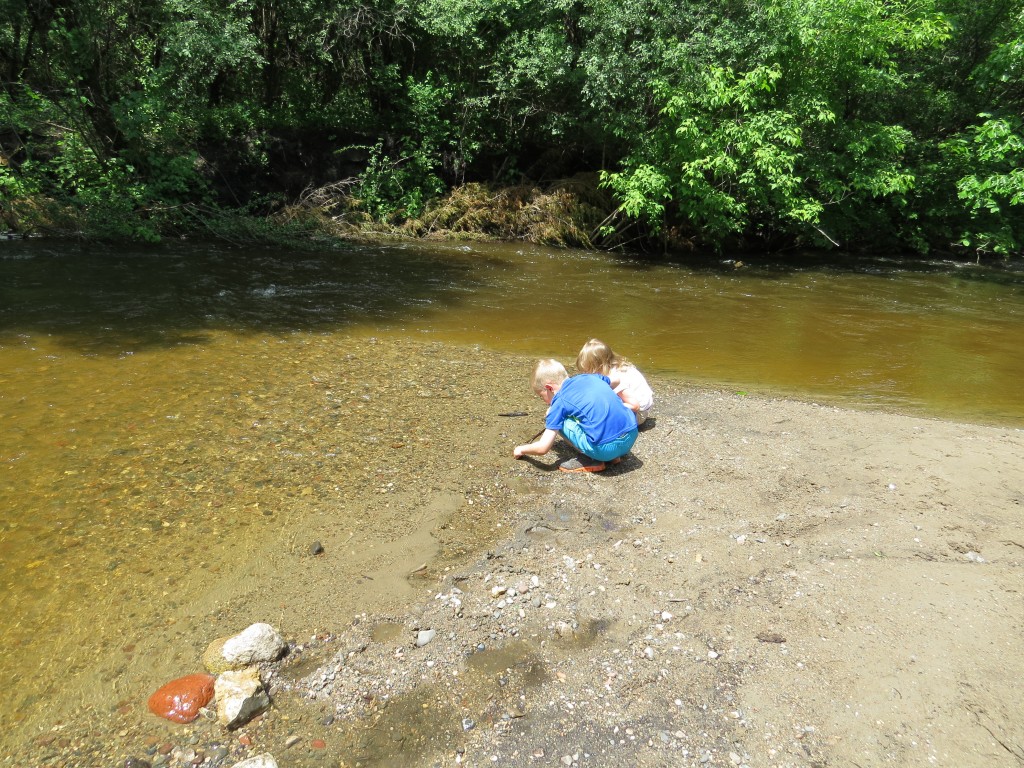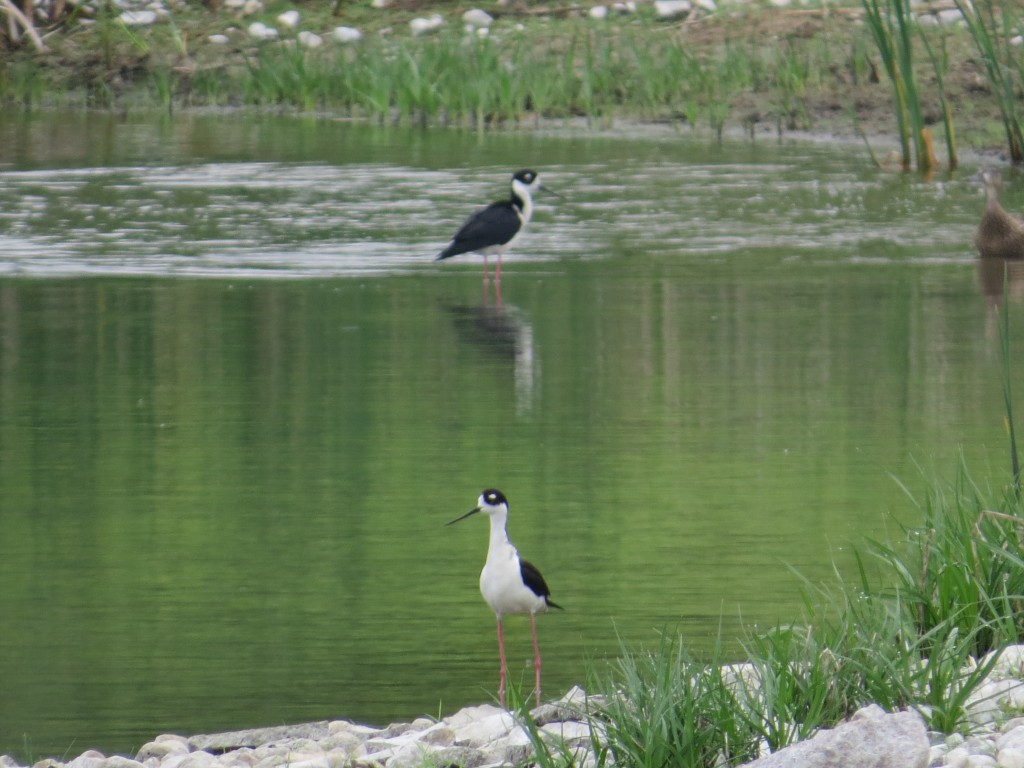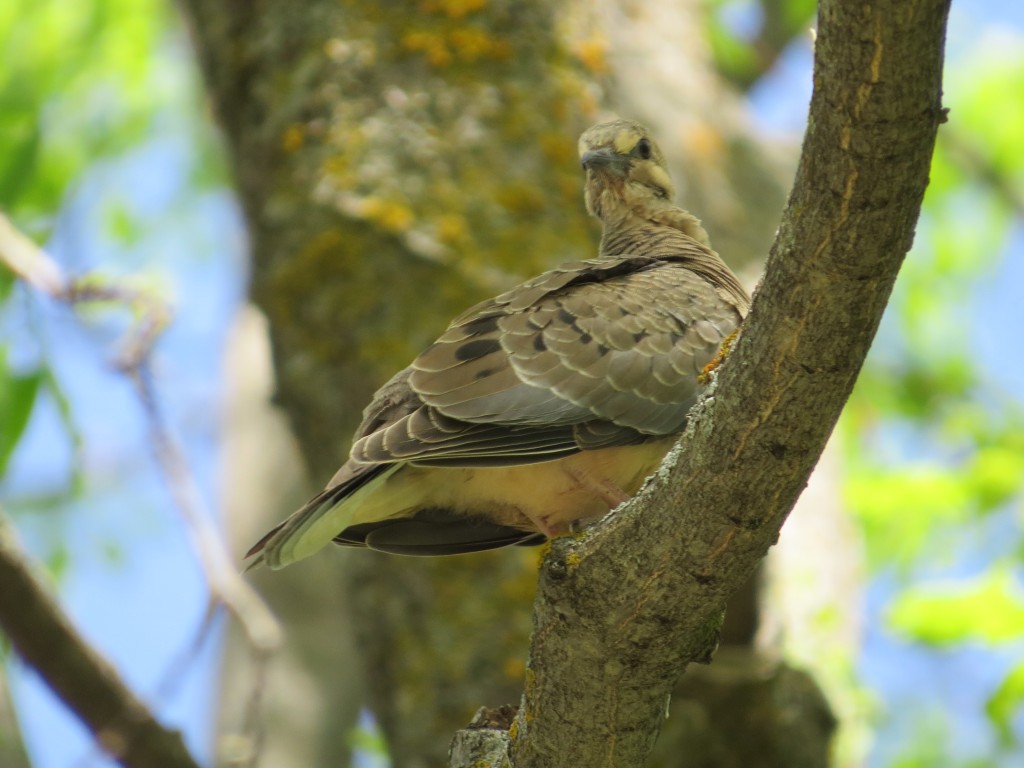Author Archives: Josh
Blue-winged Warbler
Eastern Meadowlark
Avian and Animal Adventures at Afton State Park
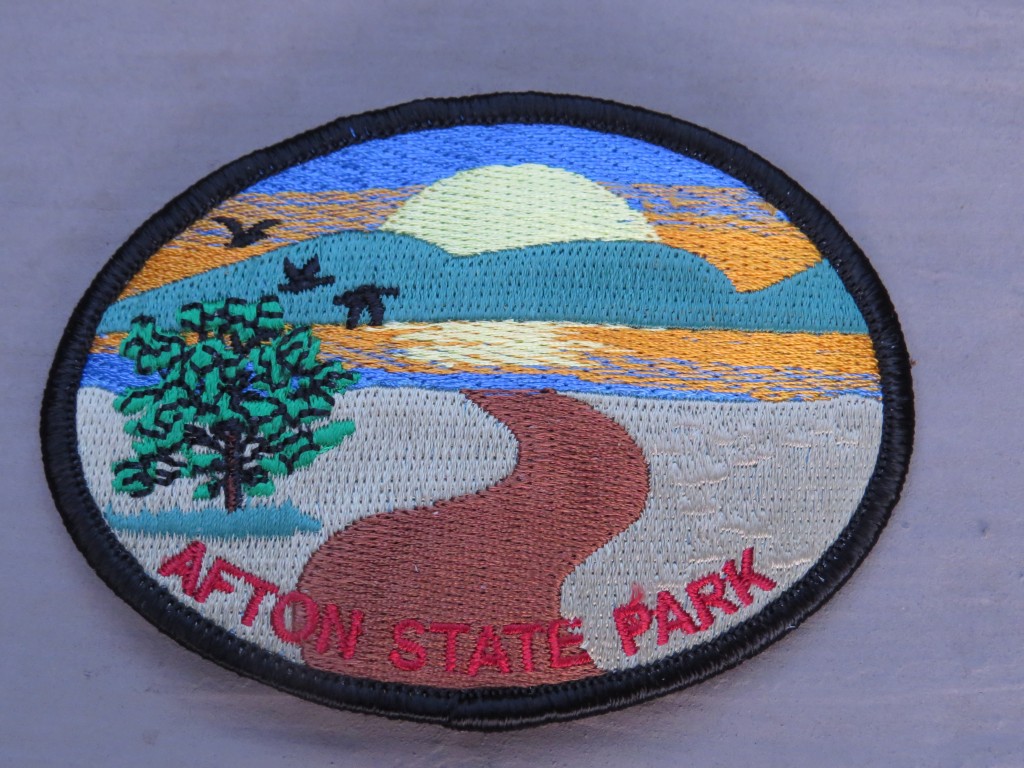 Anyone who read our blog last summer may recall that we have a special fondness for state parks, especially those that hold new and exciting birds. One of the bonuses of visiting a new state park is that Evan gets the park’s signature patch for his birding rucksack. We are not indiscriminate in which parks we visit. There has to be a compelling reason to go to a certain park. Afton State Park had been on my radar since last year when Pete Nichols, the moderator of the Minnesota Birding Facebook Group, discovered a Hooded Warbler there. Hooded Warblers are rare but regular in Minnesota, and they are a bird I’ve been wanting to see. This year Pete rediscovered not one, but three of these birds at Afton! Additionally, there were many other birds popping up at Afton that we’d never seen. The most prominent that I would consider equals with the Hooded Warbler is the Prothonotary Warbler. There were also Henslow’s Sparrows (many), Blue-winged Warblers, Black-billed Cuckoos, Eastern Towhees, Tufted Titmice, Summer Tanagers, and Bell’s Vireos. The Hooded Warbler alone would have brought me to the park which is east of St. Paul and on the St. Croix River that runs between Minnesota and Wisconsin. But this buffet of potential life birds made it a must-visit spot right now. In fact, I even pulled Evan out of a couple days of school to make the trip. Let’s face it, if we didn’t have all the snow days this past year, he’d be out of school by now anyway.
Anyone who read our blog last summer may recall that we have a special fondness for state parks, especially those that hold new and exciting birds. One of the bonuses of visiting a new state park is that Evan gets the park’s signature patch for his birding rucksack. We are not indiscriminate in which parks we visit. There has to be a compelling reason to go to a certain park. Afton State Park had been on my radar since last year when Pete Nichols, the moderator of the Minnesota Birding Facebook Group, discovered a Hooded Warbler there. Hooded Warblers are rare but regular in Minnesota, and they are a bird I’ve been wanting to see. This year Pete rediscovered not one, but three of these birds at Afton! Additionally, there were many other birds popping up at Afton that we’d never seen. The most prominent that I would consider equals with the Hooded Warbler is the Prothonotary Warbler. There were also Henslow’s Sparrows (many), Blue-winged Warblers, Black-billed Cuckoos, Eastern Towhees, Tufted Titmice, Summer Tanagers, and Bell’s Vireos. The Hooded Warbler alone would have brought me to the park which is east of St. Paul and on the St. Croix River that runs between Minnesota and Wisconsin. But this buffet of potential life birds made it a must-visit spot right now. In fact, I even pulled Evan out of a couple days of school to make the trip. Let’s face it, if we didn’t have all the snow days this past year, he’d be out of school by now anyway.
One complication with Afton is that you can’t pull a camper there. That wouldn’t be a problem as we can tent it, but the tent sites are back-pack sites which means a significant hike – not a task I wanted to do with two kids. The park’s saving grace is that it has camper cabins for rent at a very reasonable rate. So that’s what the kids and I did.
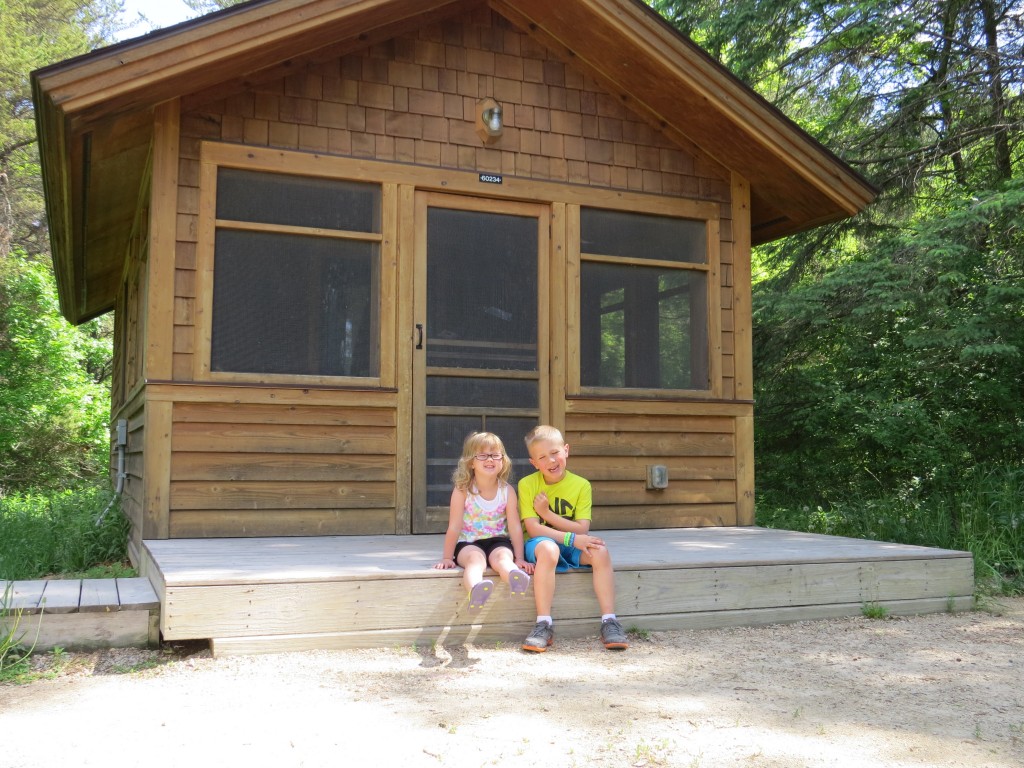
They were pretty enthralled with the accomodations. Seeing how nice the cabins were and how cheap they are to rent, I started to question why I bought a camper. Oh well, variety is the spice of camping.
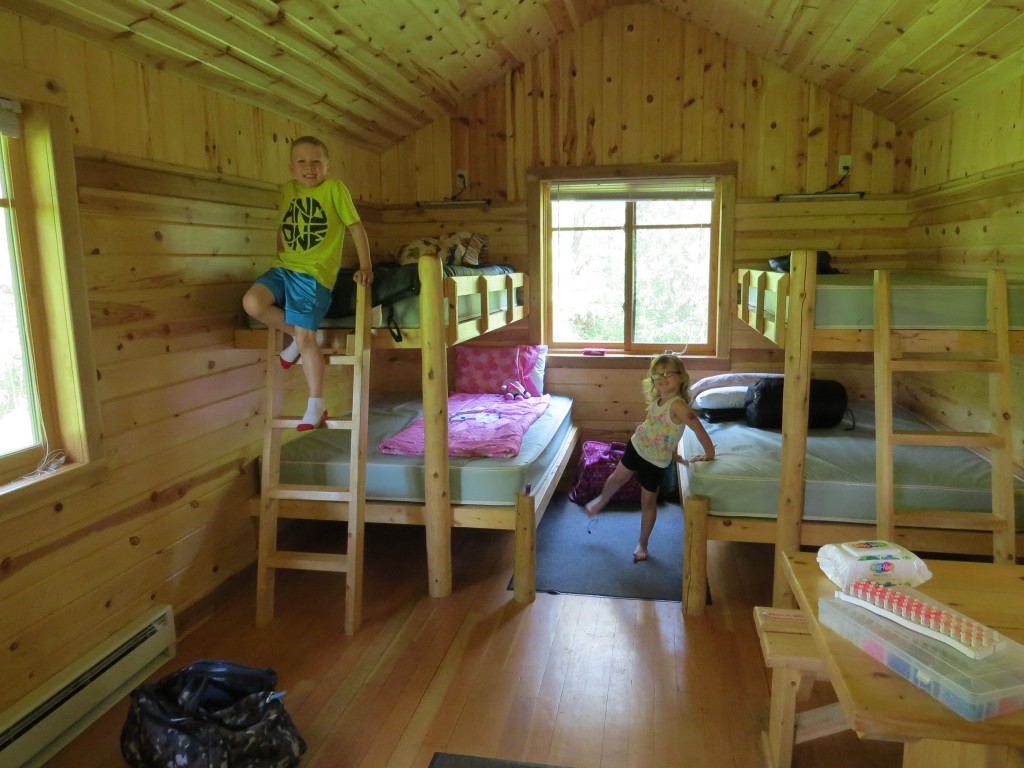
Camper Cabin at Afton State Park
The cabin was nice and all, but I was itching to find one of the nearly ten potential life birds that could be had in this park. So after we unpacked, we headed for the car to drive to our hiking destination. But I jumped back when I discovered this 4-foot Fox Snake between me and my car!
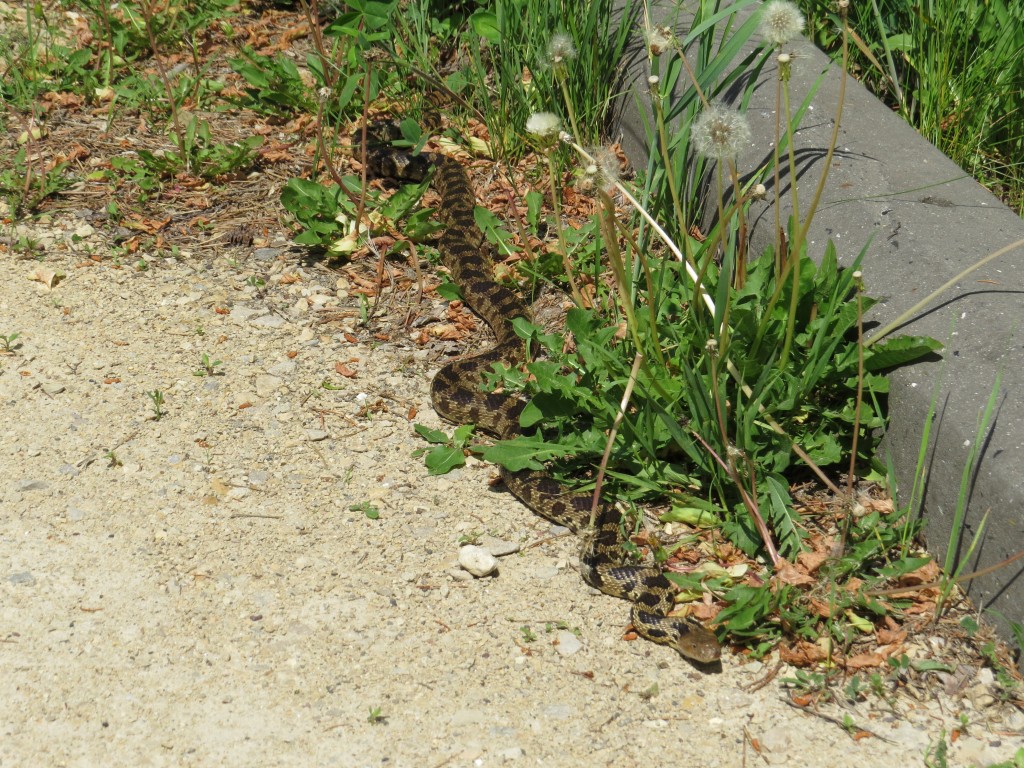
Fox Snake
What a sighting! I’ve never seen anything like it in Minnesota. The kids and I were within just a few feet of it checking it out. I couldn’t resist touching it. In my younger days I would have caught the thing, but I wasn’t up for that. He shot off like a rocket the instant he felt my touch. Then it disappeared in the weeds, gone for good. Or so we thought.
And how do we know it was a Fox Snake? Marin discovered it on a poster at the Visitor’s Center (and it was confirmed by Randy). She was quite proud that she found it.
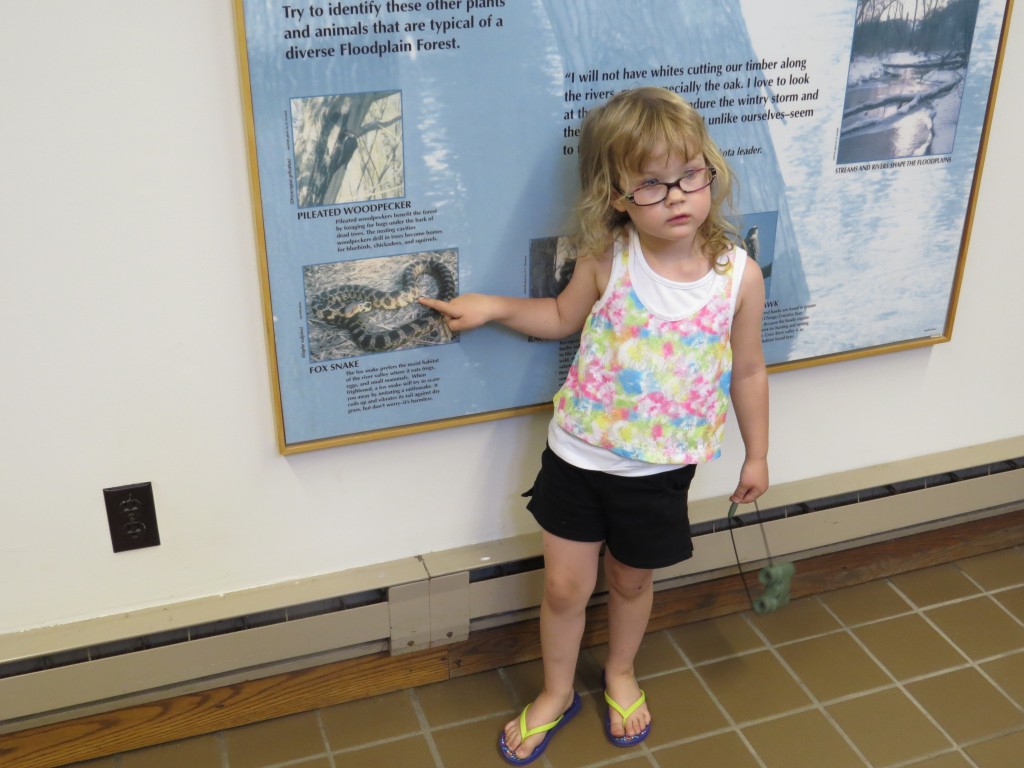
The kids and I finally made it to the area where we needed to hike for the Hooded Warbler. Our path would go down a large hill to the St. Croix River where we could walk the river bottoms trail and look/listen for this warbler. The hike down was full of stops and starts as one kid or the other had some emergency or another, mostly bug or heat related. Finally we gave up and went back to the car. No Hooded.
As we drove through the parking lot a meadowlark with a lot of white in its tail flushed up and landed in the tree next to us. I was confident it was our Eastern Meadowlark lifer because the Westerns are rare visitors to the park and the Easterns are classified as common. I was waiting for it to vocalize, the surest indication of what species of meadowlark it was.
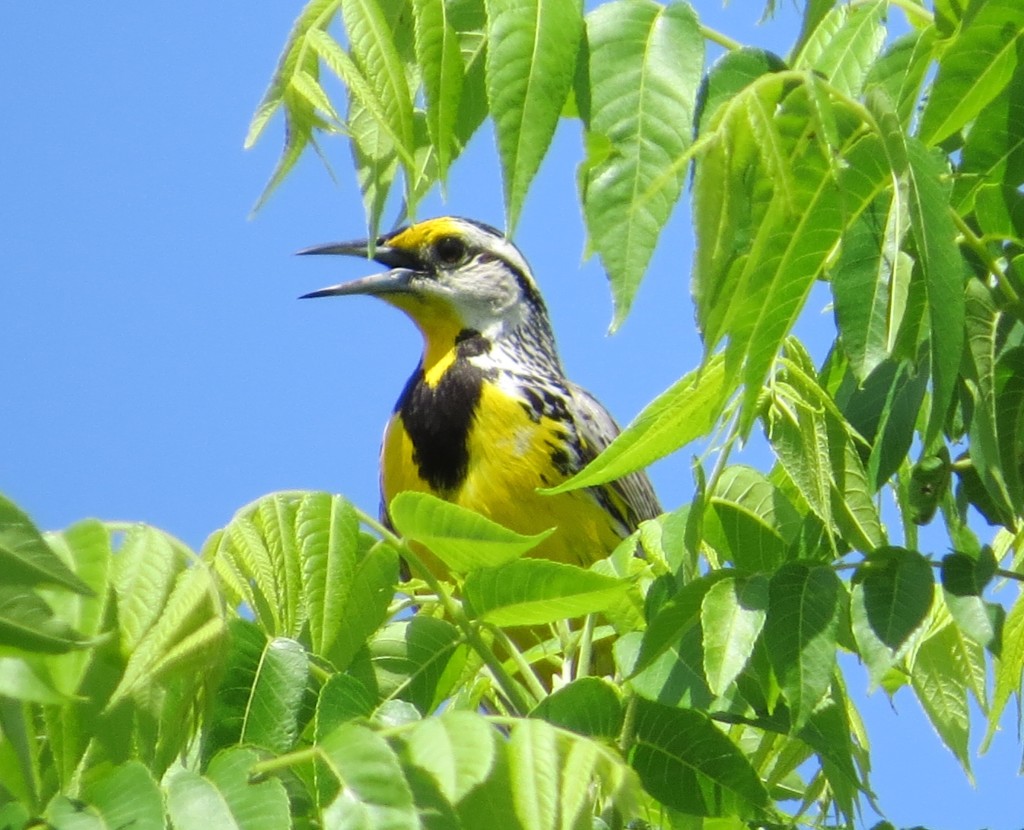
Eastern Meadowlark
As we spent more time in the park, we saw and heard many Eastern Meadowlarks. Though its simple song is far inferior to our melodic Western, it was fun to hear and be able to gain confidence in distinguishing the two species. Because it is nearly identical to the Western Meadowlark, it wasn’t an exciting life bird, just a tick on the life list.
When we got back to cabin, we had another visitor – the Wild Turkey. This tom (he’s shy about showing his beard) didn’t really care that he was blocking our way.
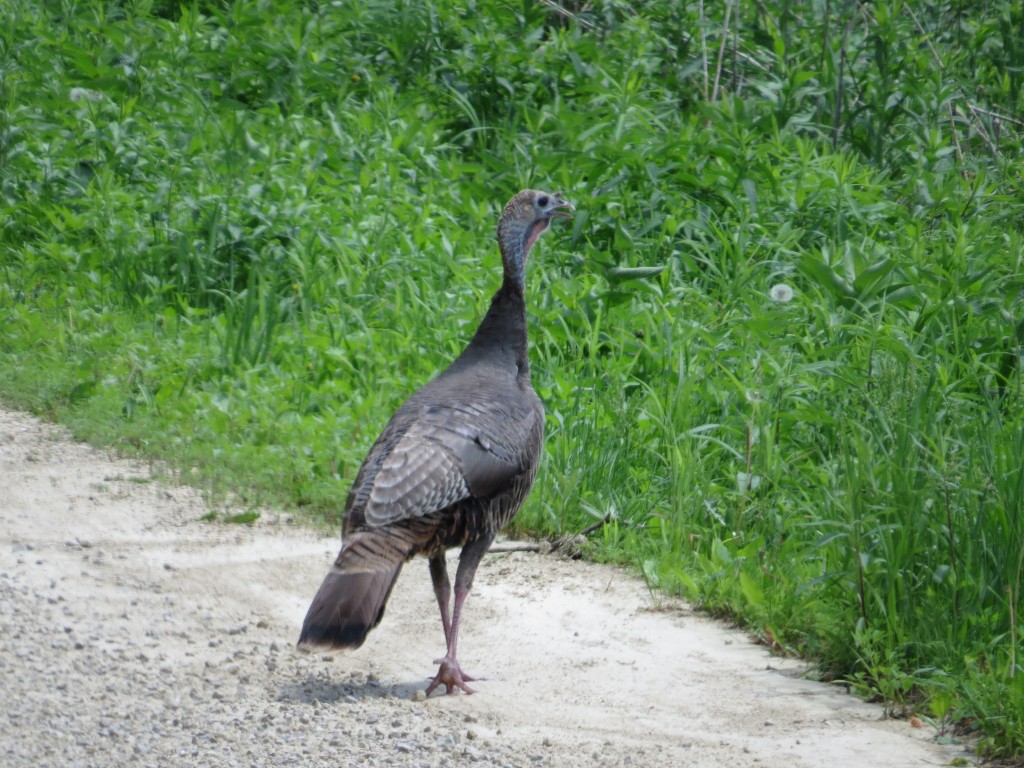
Wild Turkey
After some lunch, a nap, and some bunk-bed antics, it was time to go out for another walk. This time we were going to hit the north prairie loop to look for Henslow’s Sparrows, Black-billed Cuckoos, and Blue-winged Warblers.
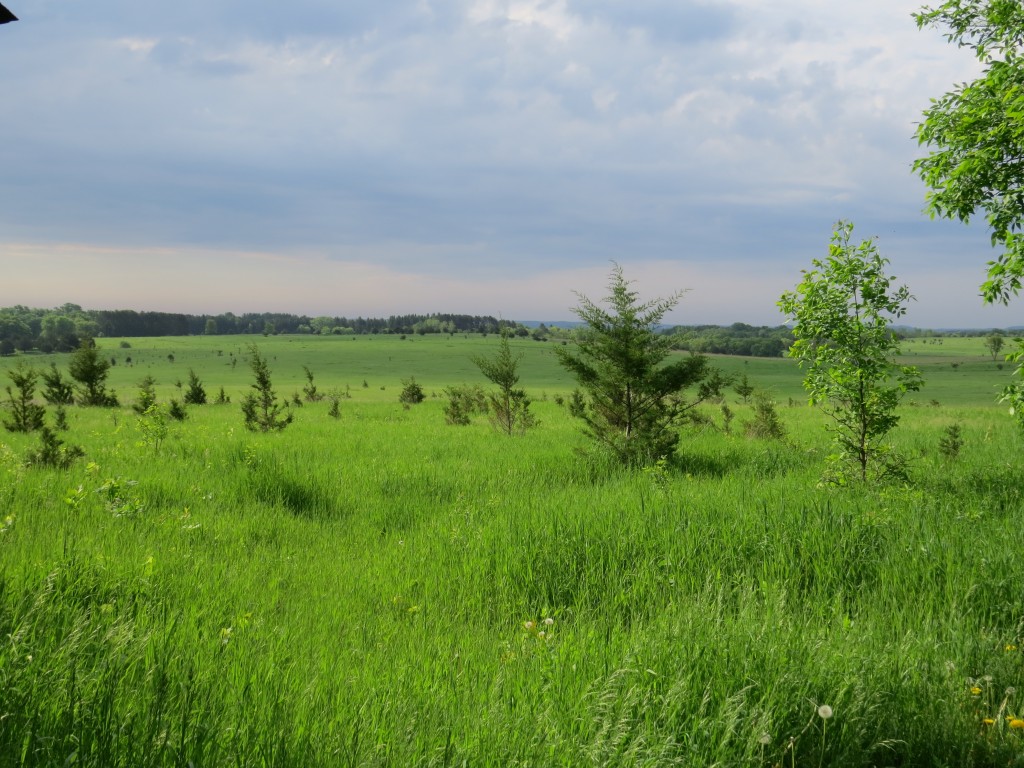
North Prairie Loop – Afton State Park
We walked in the hot sun and didn’t come up with anything. I didn’t hear a Henslow’s, and I certainly didn’t see a Cuckoo in the nearby woods. We did end up seeing our Blue-winged Warbler lifer in flight. It was a dull yellow with bluish wings, and it was in an area where they had been seen. We saw it fly into a pine. I watched for it to show itself, but then an American Goldfinch popped out. I asked Evan if that’s what we had seen. His answer confirmed my own thoughts when he said the one we saw wasn’t as yellow and had blue wings. Finally our bird popped out again, flying away and not landing in sight. Bummer. It’s not the way I’d like to get a lifer. A good solid view is a must followed by a good photo.
At least this Eastern Bluebird posed for a photo even though they are quite common wherever there is prairie. Though I wish a Black-billed Cuckoo were sitting in his place, I couldn’t pass up a chance to photograph a bluebird.
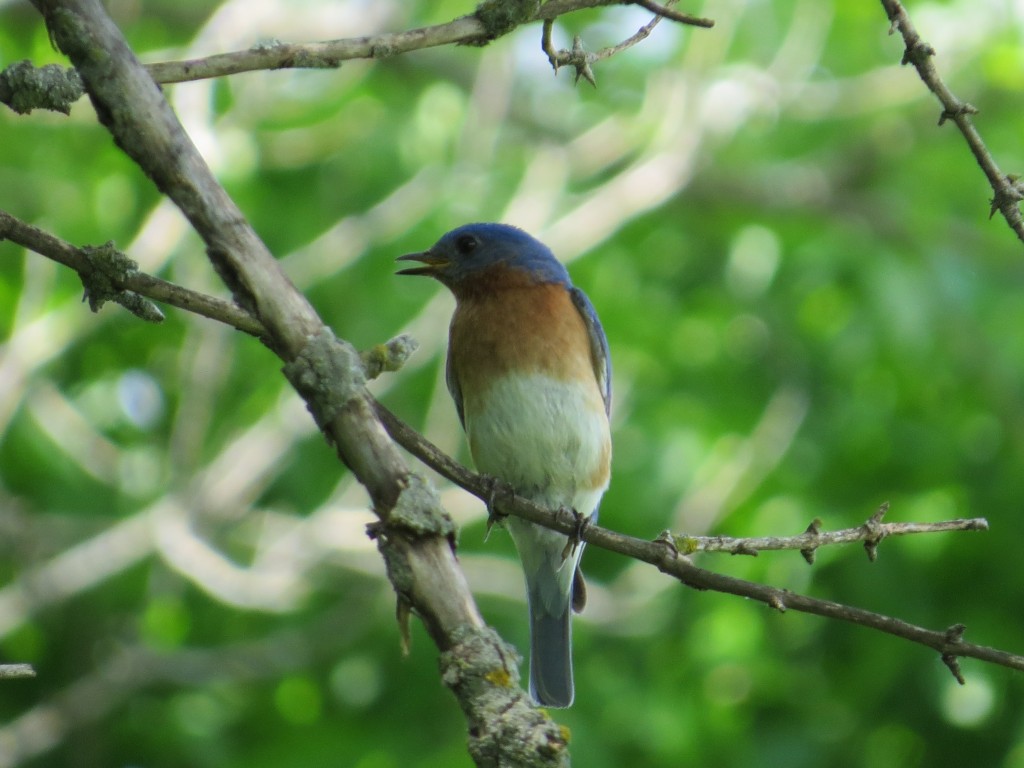
Eastern Bluebird
After our prairie hike it was back to the cabin for more food and rest (me) and more horseplay (the kids). I told the kids we’d go on one last hike in the early evening and then come home to make a fire and cook supper. This time I was determined to get us down to that river bottoms trail to adequately search for that Hooded Warbler.
We drove a little ways down the road and look who was sunning himself! I’m not sure this is the same snake as before or even the same species. But two mega snake sightings in one day was incredible!
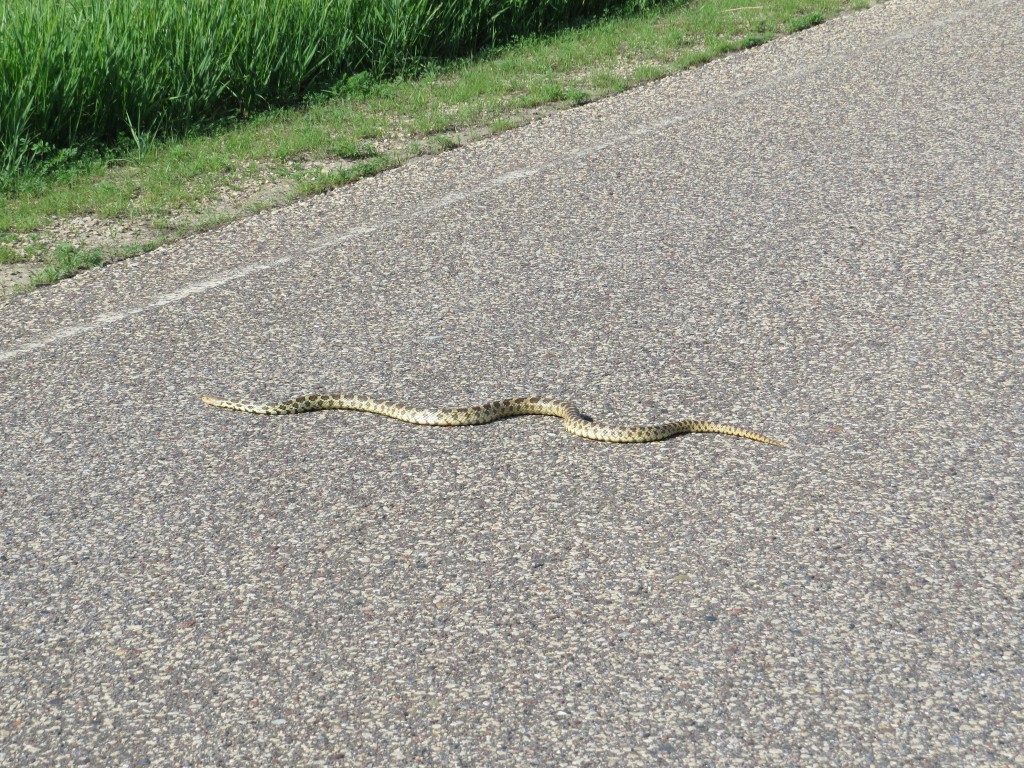 After this experience we finally made it to the trailhead. This time things went a lot smoother with a lot less complaining. The hike down the large hill was the most challenging as the sign shows, though Marin was convinced the sign meant it was a snake trail. Given our day, who could blame her? Here you can see Evan contemplating her observation.
After this experience we finally made it to the trailhead. This time things went a lot smoother with a lot less complaining. The hike down the large hill was the most challenging as the sign shows, though Marin was convinced the sign meant it was a snake trail. Given our day, who could blame her? Here you can see Evan contemplating her observation.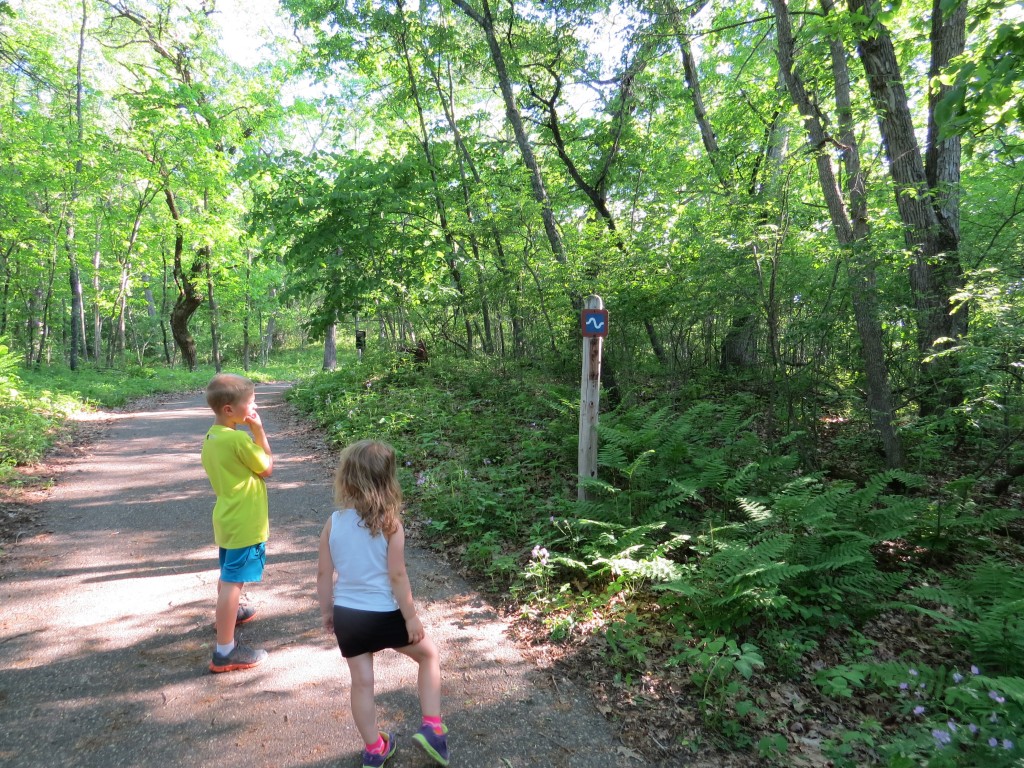 The river bottoms trail was flat and easy as it took us right next to the St. Croix and right along the base of an oak-wooded hillside where the Hooded Warblers were known to be. I knew the song well as its been my phone’s ring tone for some time, but I just wasn’t hearing it. Argh. Later on, though, as we passed by some flooded timber along the edge of the river, I heard the distinctive call of the Prothonotary Warbler! Not the main target, but good enough! After a little while we got to lay our eyes on it. What a thrill it was to see it for the first time!
The river bottoms trail was flat and easy as it took us right next to the St. Croix and right along the base of an oak-wooded hillside where the Hooded Warblers were known to be. I knew the song well as its been my phone’s ring tone for some time, but I just wasn’t hearing it. Argh. Later on, though, as we passed by some flooded timber along the edge of the river, I heard the distinctive call of the Prothonotary Warbler! Not the main target, but good enough! After a little while we got to lay our eyes on it. What a thrill it was to see it for the first time!
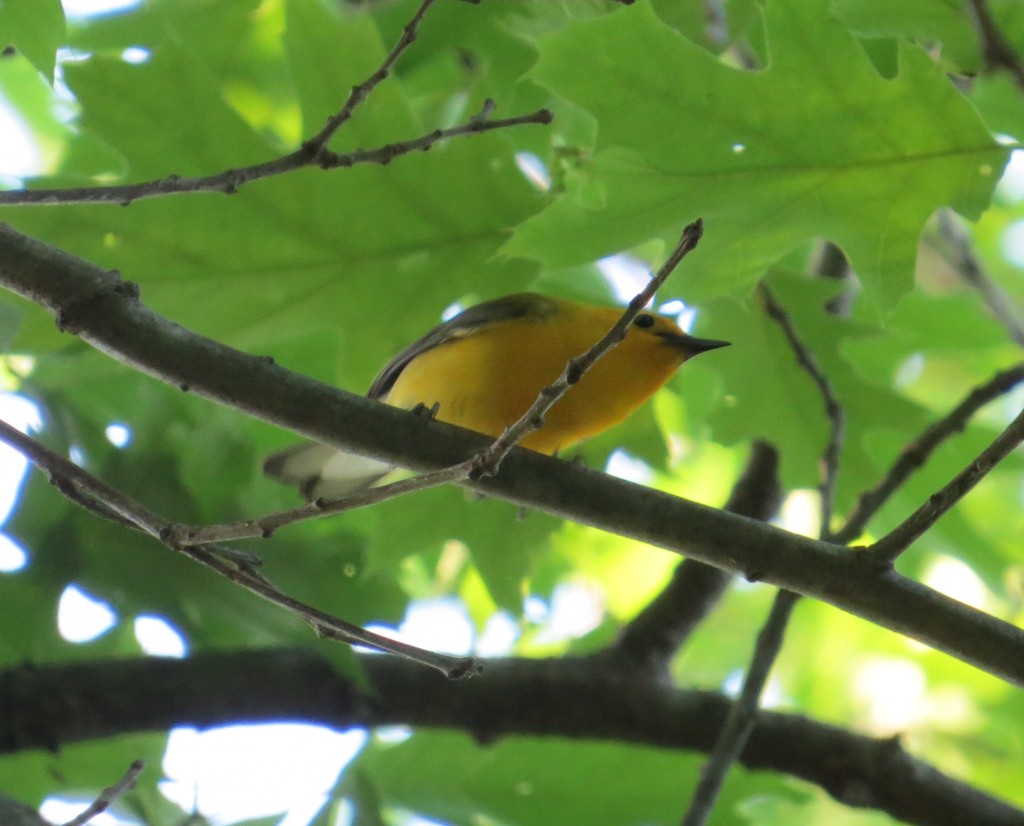
Prothonotary Warbler
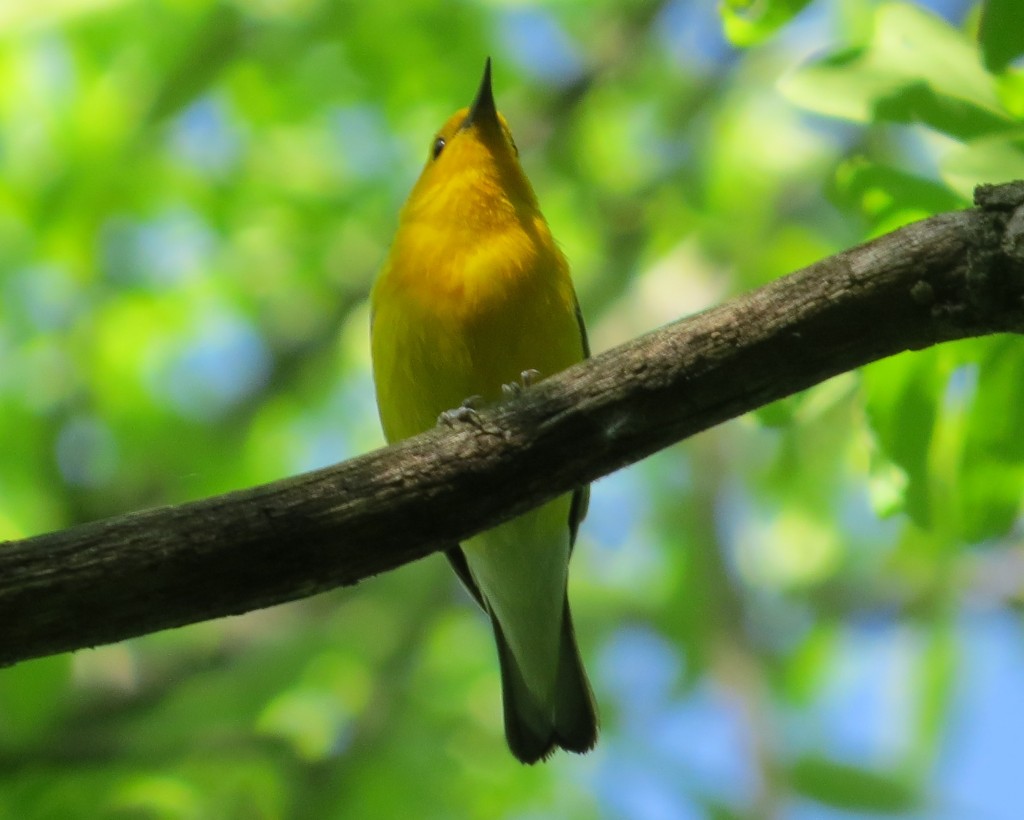
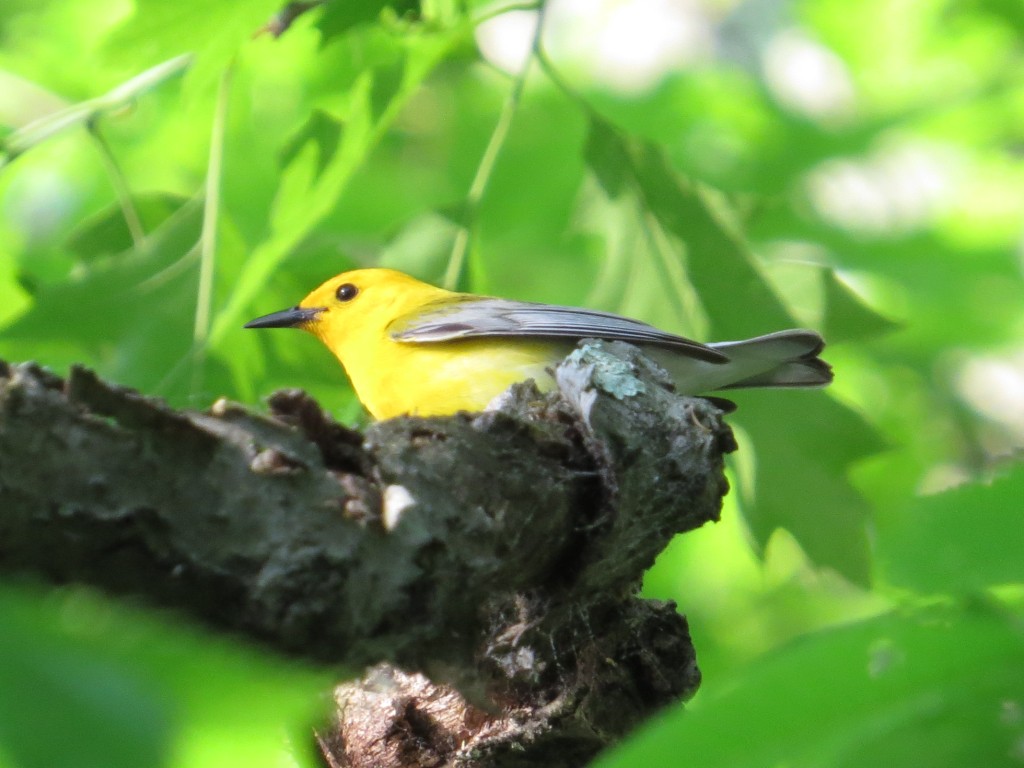
If there would be no Hooded Warbler, it didn’t matter so much anymore with this bird. It was quite a sight. We never did see the Hooded that day; it would have to wait until the next day. The kids were tired, so we headed back to the cabin for supper and bed even though there was a good hour or so of daylight left. We pulled in to find yet some more visitors in the campsite – three deer!
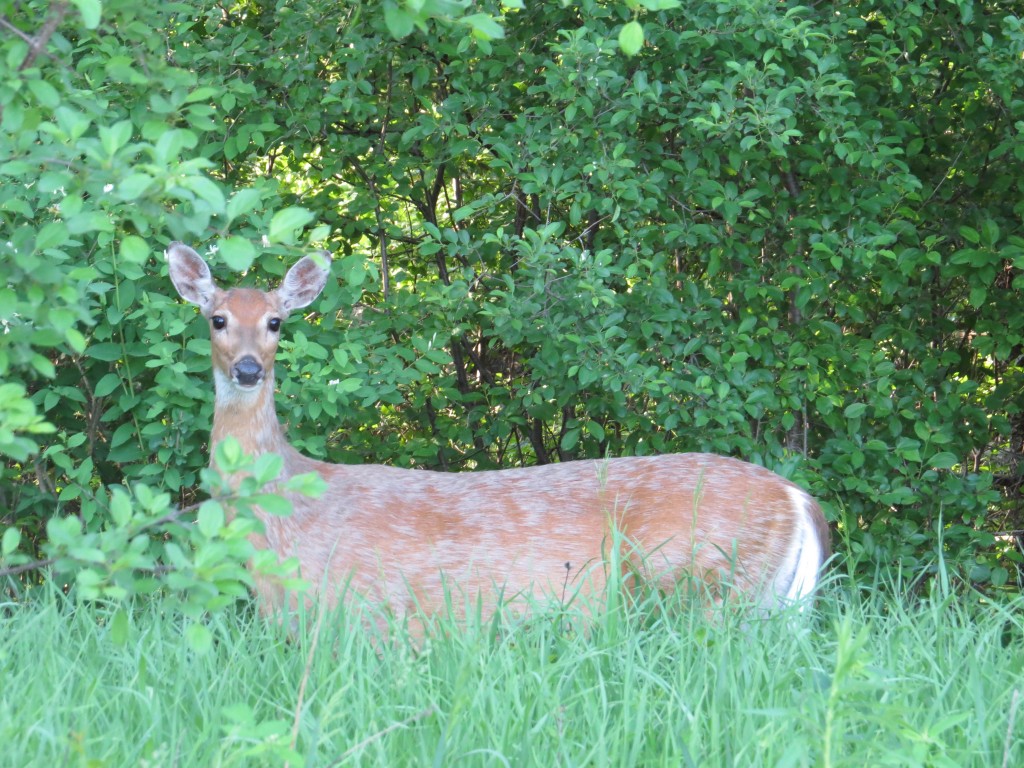
As I had made a trip out to the car after getting the kids in their pajamas, I heard the distinctive “Drink your teaaaaa!” song of the Eastern Towhee! This would be a life bird, and its song was coming from across the prairie to the south of our cabin. Quickly I had the kids throw their shoes on, and we followed this bird’s song. I was able to locate it at the top of a dead tree belting out his tune for everyone to hear. And he did not care that we were watching him from down below. Nor did he care that Marin sang his song with him. I’ve been looking forward to seeing this bird for a long time, so it felt pretty good to get this one on the trip.
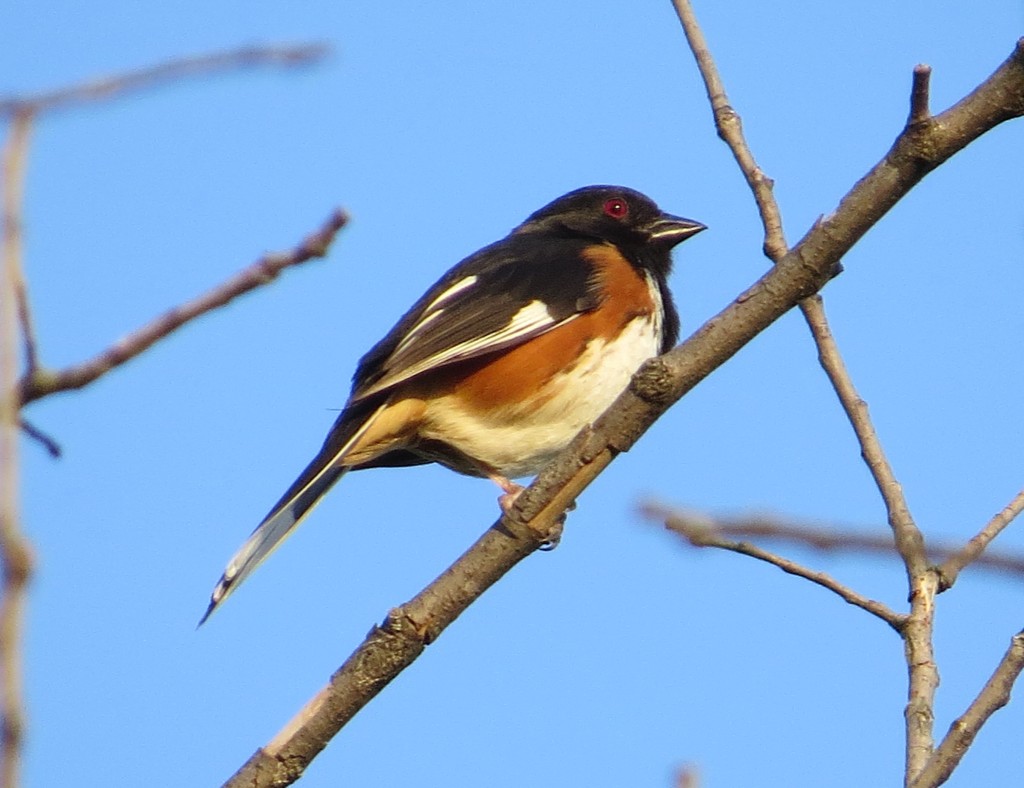
Eastern Towhee
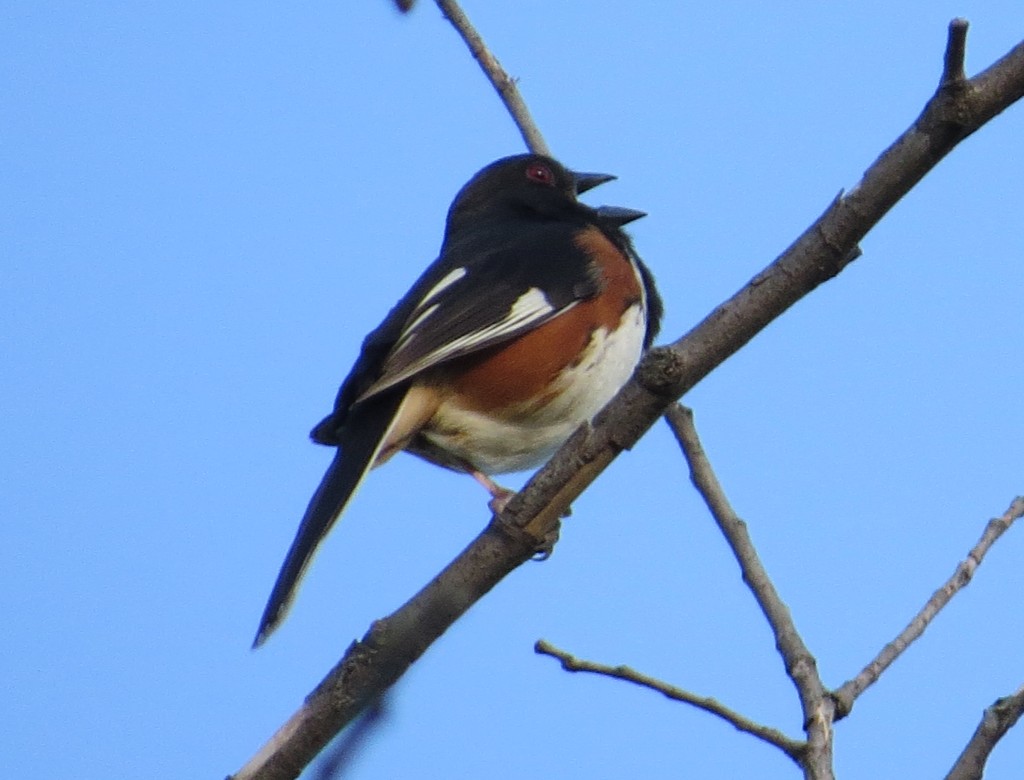
“Drink your teaaaaa!”
When we got back to the campsite this time, a fox scampered out of our campfire area. What a magnet for wildlife this little spot was. It would be fun to see what the next day would bring.
That next day I decided we would do the river bottoms trail one last time and the prairie loop one last time. If we didn’t get our main target or some other lifers then so be it. All the river bottoms trail yielded was another look at the Prothonotary Warbler which never gets old. The prairie loop trail didn’t provide the Henslow’s Sparrow we were looking for or give any better looks at that Blue-winged Warbler. It was fun to see a Field Sparrow, which is a fairly uncommon bird.
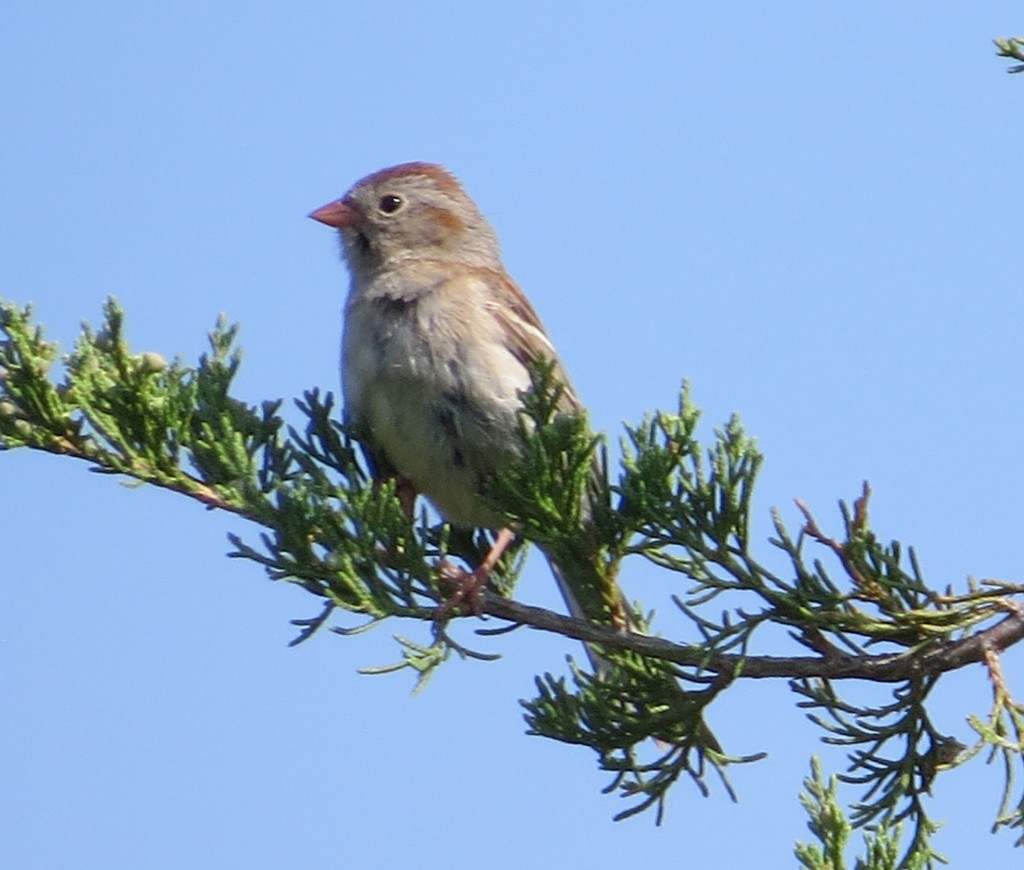
Field Sparrow
It was also a treat to see a male Orchard Oriole, even if he was a long ways from the road.
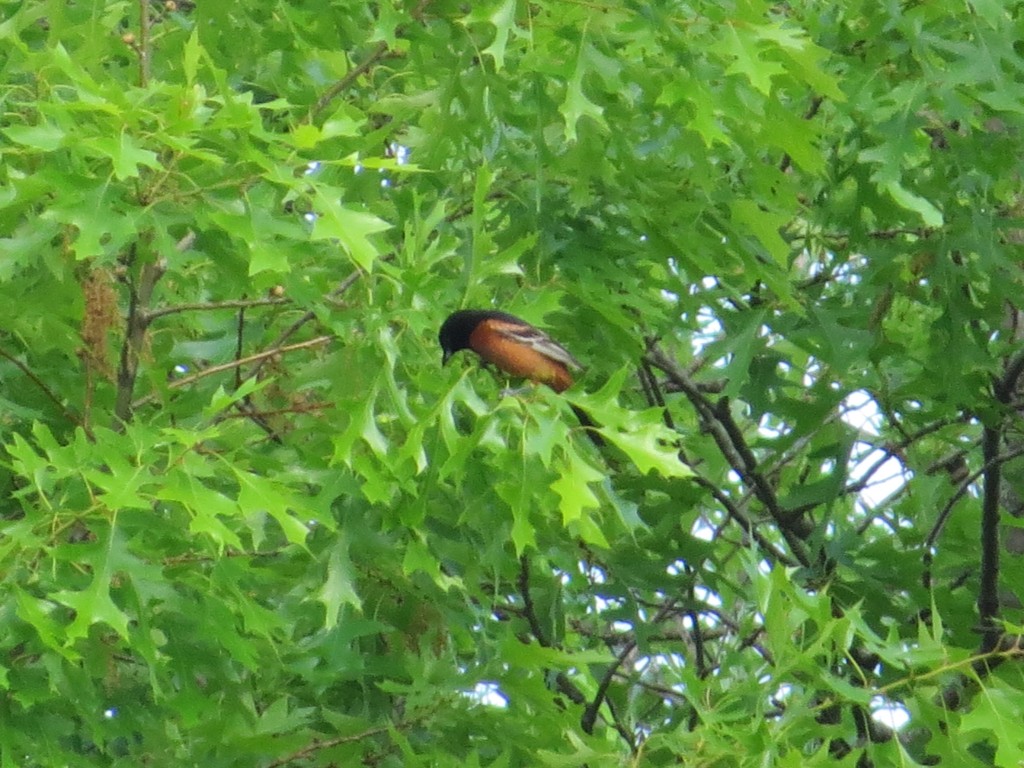
Orchard Oriole
It was finally time to go. I had a couple more birding moves to make, though. The night before someone reported a pair of Tufted Titmice at the Hidden Valley Park in Savage. I decided we’d swing by and check it out. There were plenty of birders there, but there were no binoculars or cameras pointing to the trees – not a good sign. Turns out that no one had been seeing them all day. The kids had fun at this cool, well-named park that had a small river running through it. The big draw for them was looking for tiny shells.
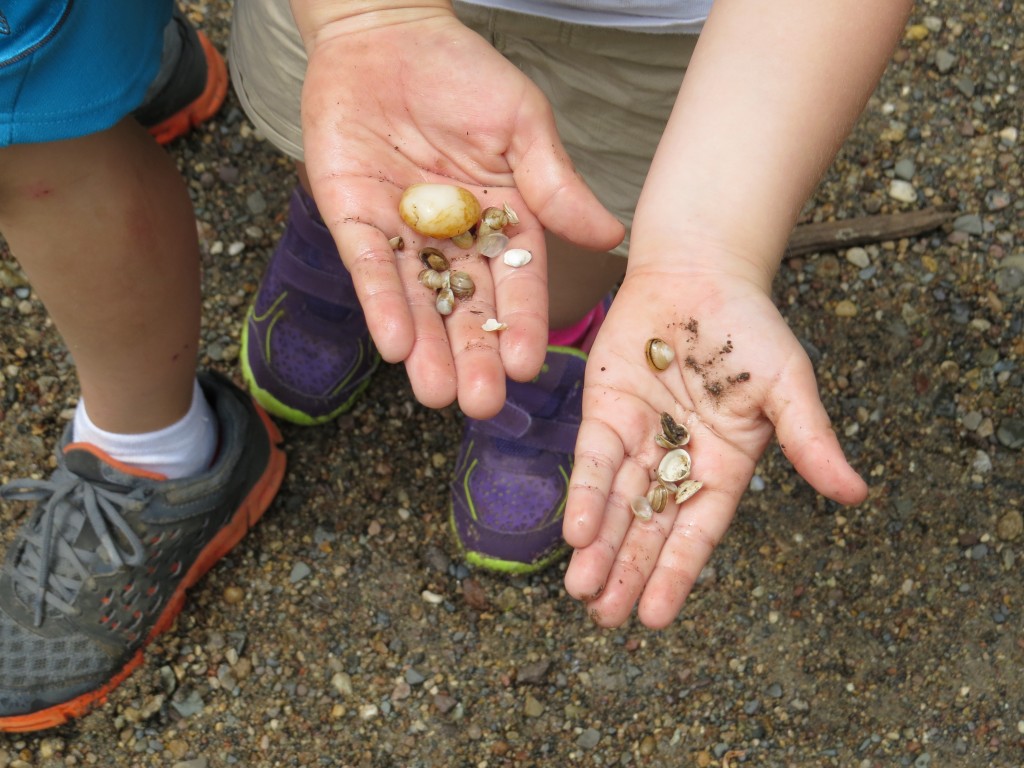
No Titmice and a handful of shells. At least some of us were happy with this place. I did see two male Indigo Buntings, a much more colorful bird than the drab Tufted Titmouse. Ironically, because of its commonality, it is a lot more boring than a Titmouse.
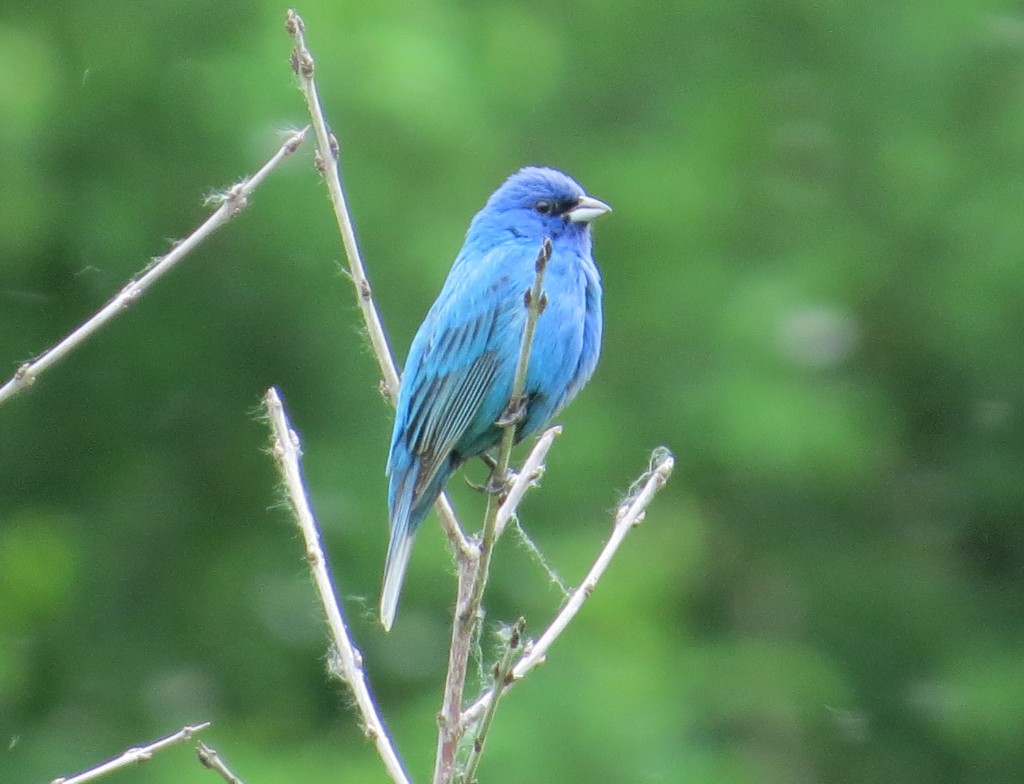
Indigo Bunting
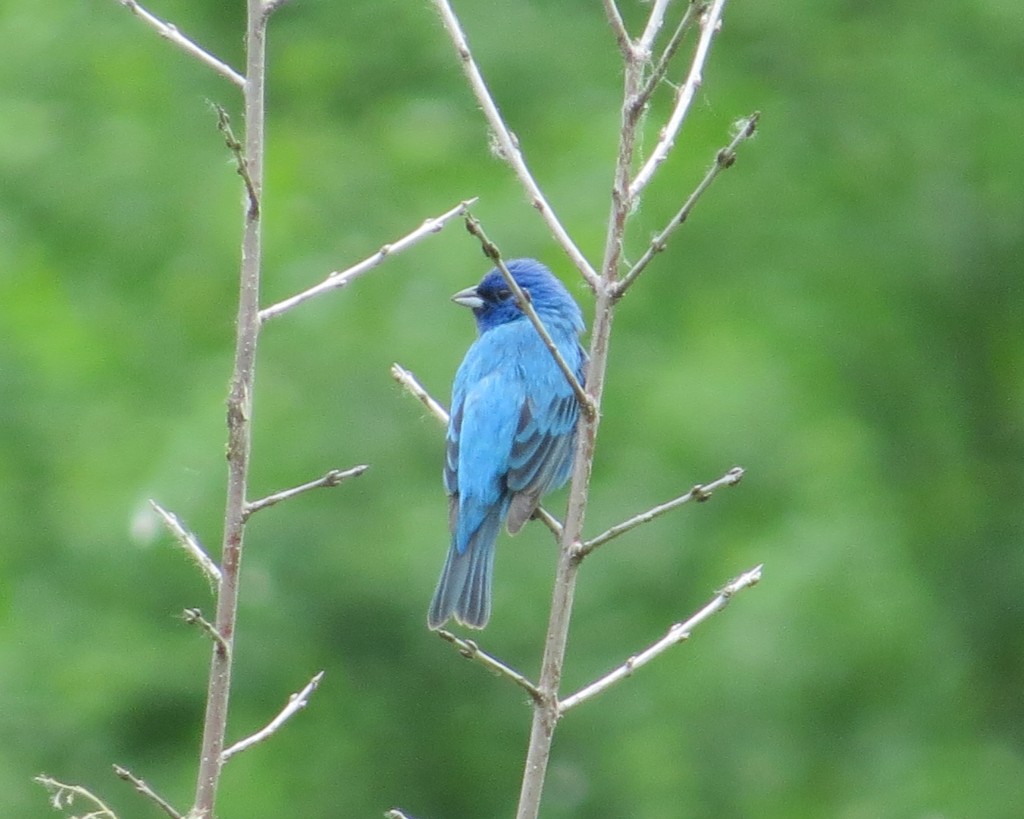
We gave up on the Tufted Titmice and made one quick stop at Murphy-Hanrehan Park for another reported Hooded Warbler. The walk was short, and so was the birding. This Hooded Warbler wasn’t singing or showing either. I guess I can’t complain. Four life birds and some other cool wildlife sightings made for a memorable trip. Plus, we still have a warbler to hunt (the list hasn’t gotten quite short!).
Cattle Egret
White-winged Dove
An Unforgettable Field Trip to Grant County and the North Ottawa Impoundment
A lot of fascinating bird reports have been pouring out of Grant County which is just a little more than an hour to the northwest. The biggest news that came last week was a confirmed nesting pair of Black-necked Stilts. These stilts normally reside in the souther reaches of our country and rarely stray into Minnesota, let alone nest here. So as people were going to check out this historic find, they were turning up other good birds like Black-crowned Night Herons, Cattle Egrets, and Loggerhead Shrikes. And just yesterday another southwestern bird popped up within 10 miles of all this action, the White-winged Dove!
Randy invited us to go a field trip to Grant County. The big attraction for Randy was the White-winged Dove which would have been a new state bird for him. The dove was just one of many phenomenal birds I was interested in. Needless to say, we accepted Randy’s offer. Evan and I were up at 4:30 this morning so we could get up to Grant County to wait at a fellow birder’s feeders for the White-winged Dove to make an appearance.
As we drove we encountered a brutal rainstorm, but we were confident that the forecast of scattered storms would allow us at least some weather-free moments to check on these birds. Finally we got to the site of the dove which was a farm place down a half-mile long driveway and tucked inside a densely wooded yard. It was not what I expected. I figured we’d be able to park our car and just watch a feeder, but the feeder was on the back side of the house. The only way to view it was to walk around the house or look through the house’s windows. We decided to creep around the house. Randy led our silent single-file procession. Immediately he said, “On the feeder right now.” Wow, that was fast! The bird then flew up into a tree posing nicely for spectacular views.
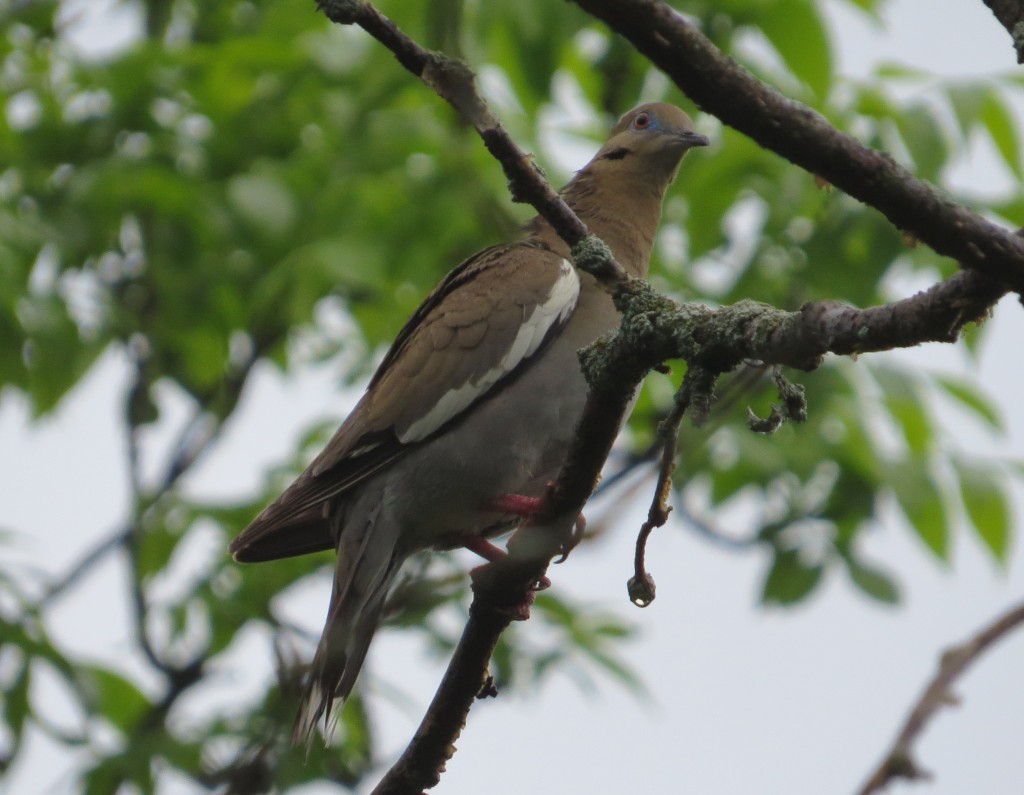
White-winged Dove
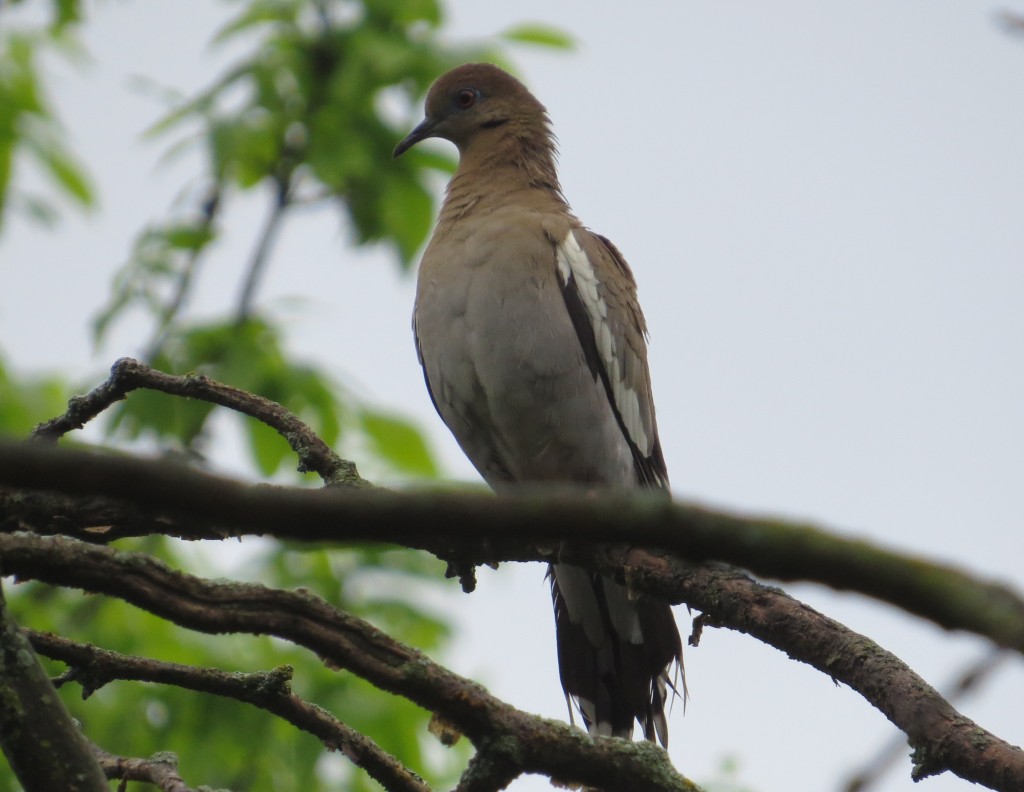 After our lightning-fast, dynamic sighting, we knocked on the door to thank Charlene, the birder and homeowner who made this amazing discovery. Charlene was the epitomy of Minnesota-nice, offering us coffee and donuts and showing us a plat book and telling us where to find other great birds in the area. It’s always a pleasure to meet a friendly birder in the field.
After our lightning-fast, dynamic sighting, we knocked on the door to thank Charlene, the birder and homeowner who made this amazing discovery. Charlene was the epitomy of Minnesota-nice, offering us coffee and donuts and showing us a plat book and telling us where to find other great birds in the area. It’s always a pleasure to meet a friendly birder in the field.
Next we were on to the North Ottawa Impoundent, which is a 2 mile by 0.5 mile rectangular pool used to provide flood relief for the Rabbit River, Bois de Sioux River, and Red River. Before we got there, though, there were many good birds to see, like the abundant Bobolinks.
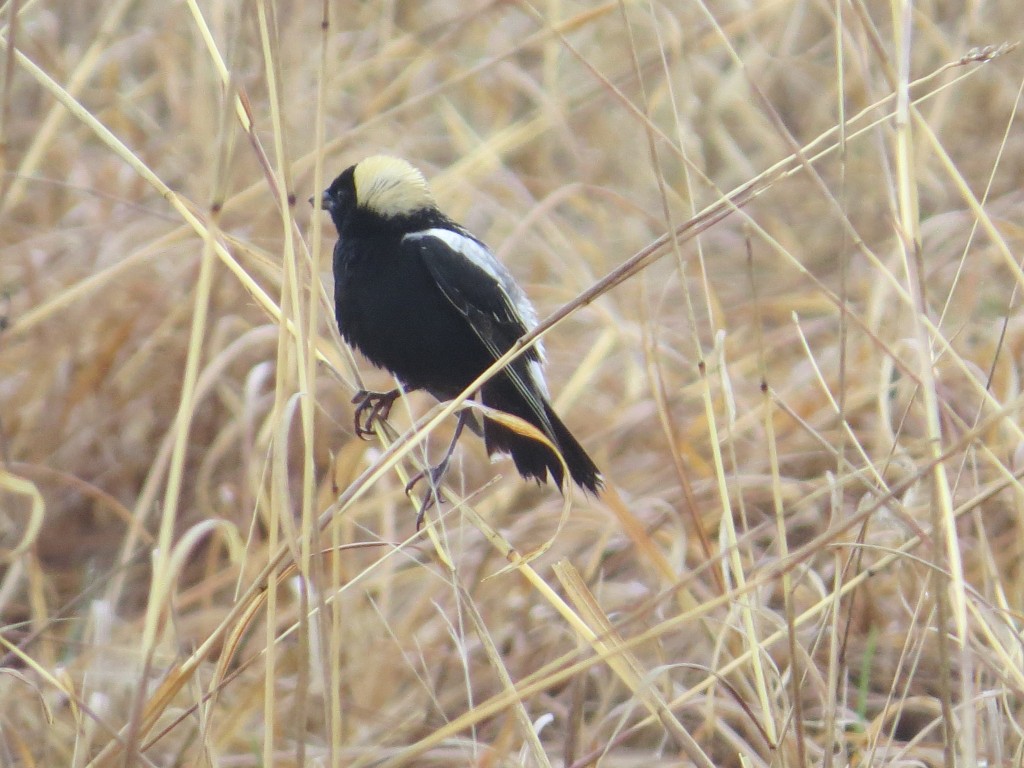
Bobolink
The North Ottawa Impoundment was an attraction for me because of the reported Black-crowned Night Herons and Cattle Egrets, both of which would be lifers. When we got to the impoundment, we immediately saw numerous Great Egrets. We kept hoping one of the white birds would be our nemesis Cattle Egret. Eventually Randy spied the two Cattle Egrets that had been reported. Finally! It was quite a thrill to now gain two life birds from this field trip.
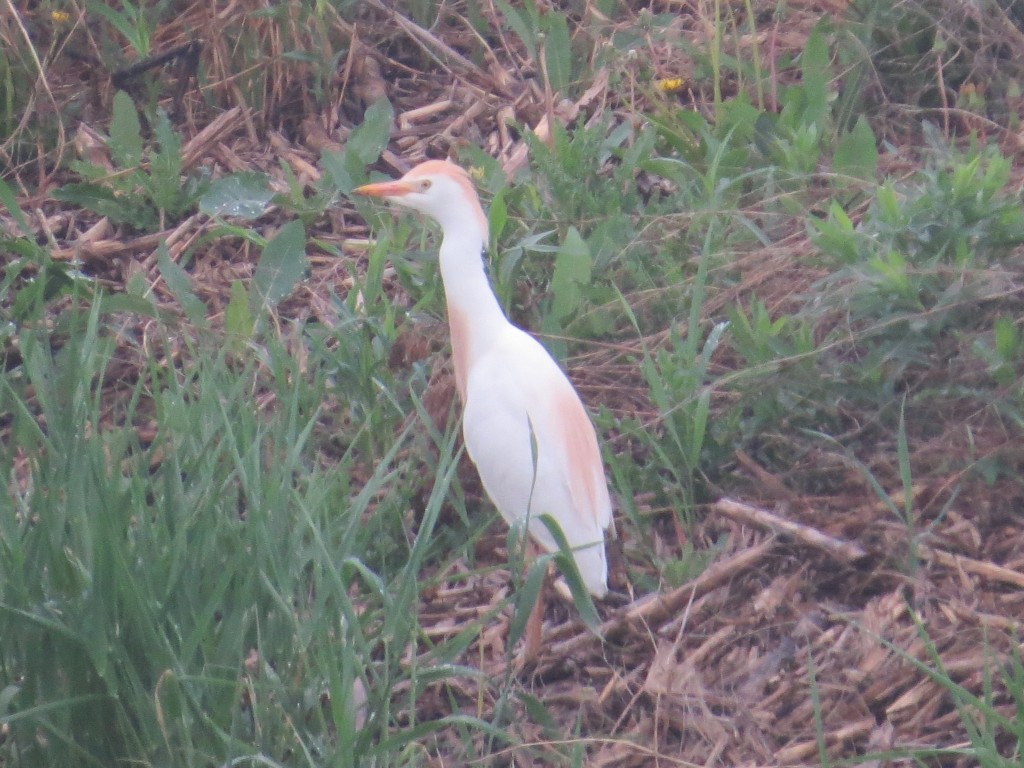
Cattle Egret
These egrets were quite shy and did not give many photo opportunities. The following picture was fun because it clearly shows the size comparison with the Great Egret, and clearly there is no comparison.
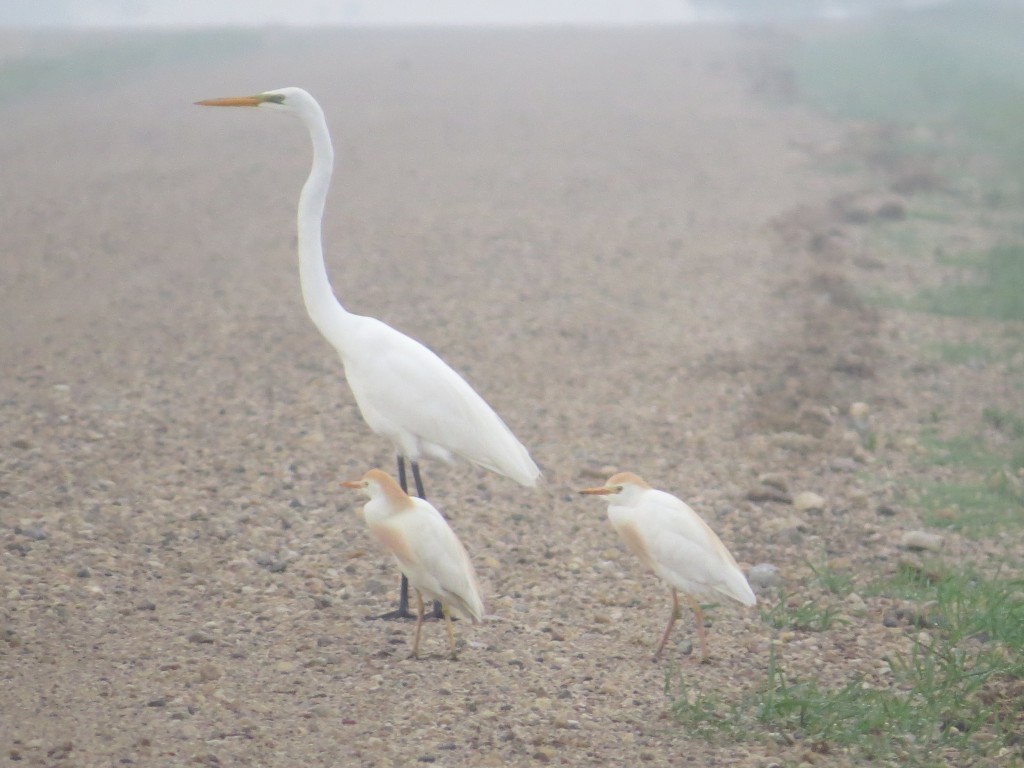
Great Egret and Cattle Egrets
Driving around the impoundment was a magical experience. There were cool birds everywhere. I guess while I was out of the car trying to photograph these egrets, Randy found an Upland Sandpiper. Additionally, there were hordes of ducks with other goodies mixed in, like numerous Eared Grebes, a Red-necked Phalarope, and a Wilson’s Phalarope. Taking a short walk allowed us to get good looks at many of these birds.
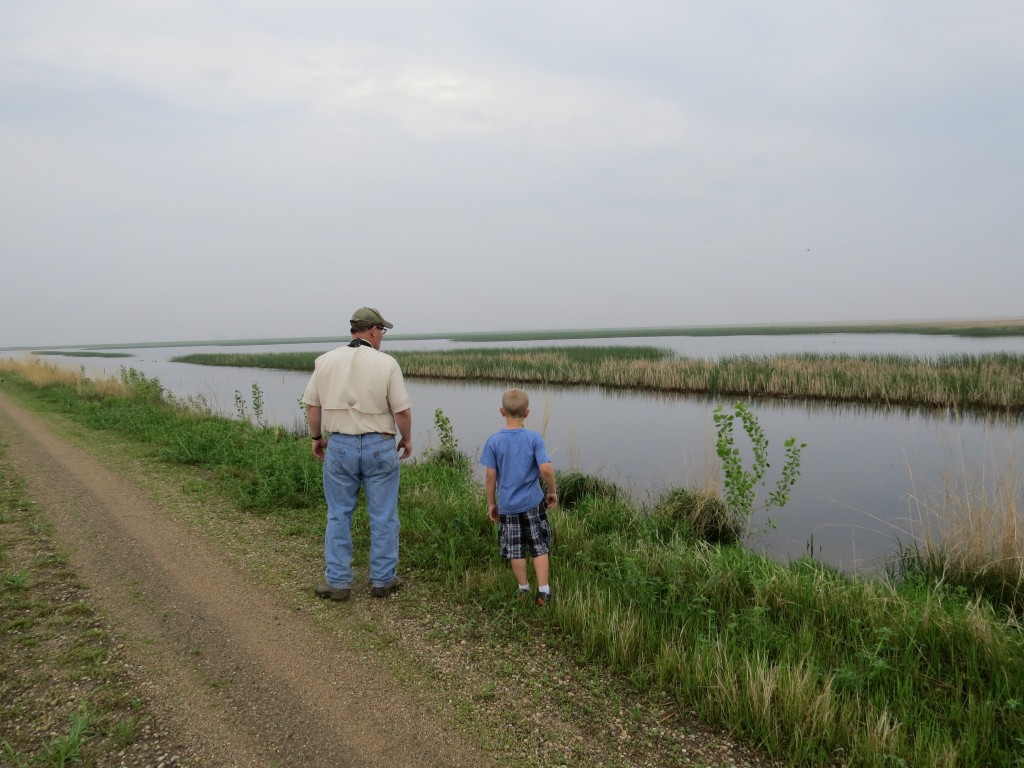
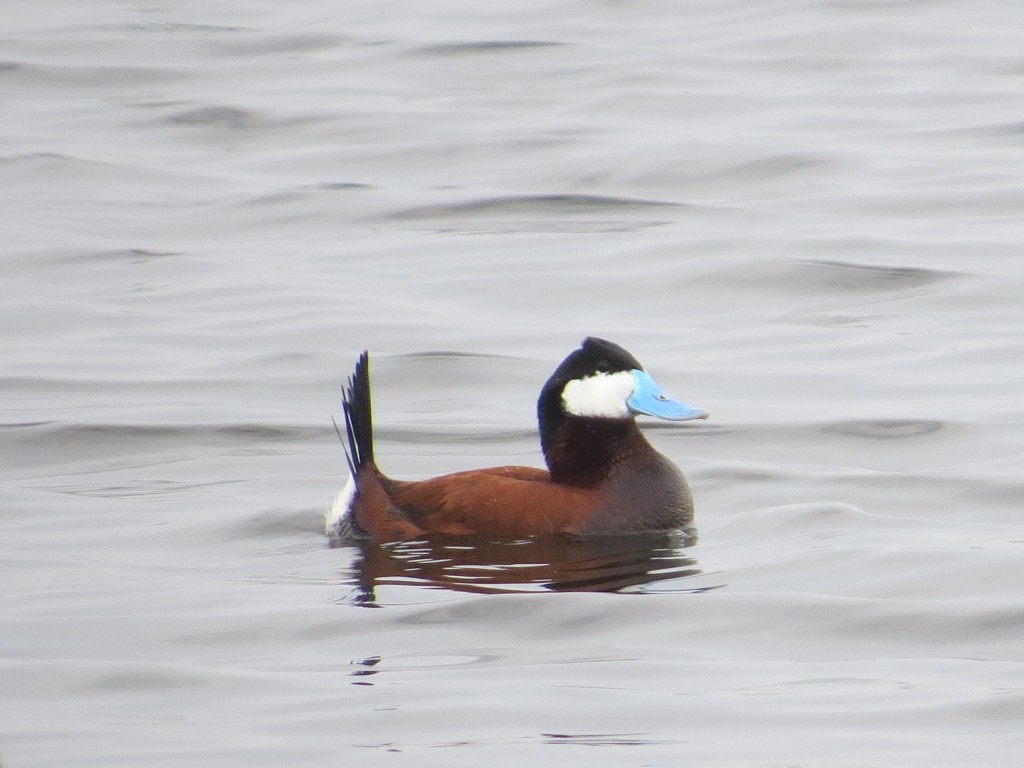
Ruddy Duck
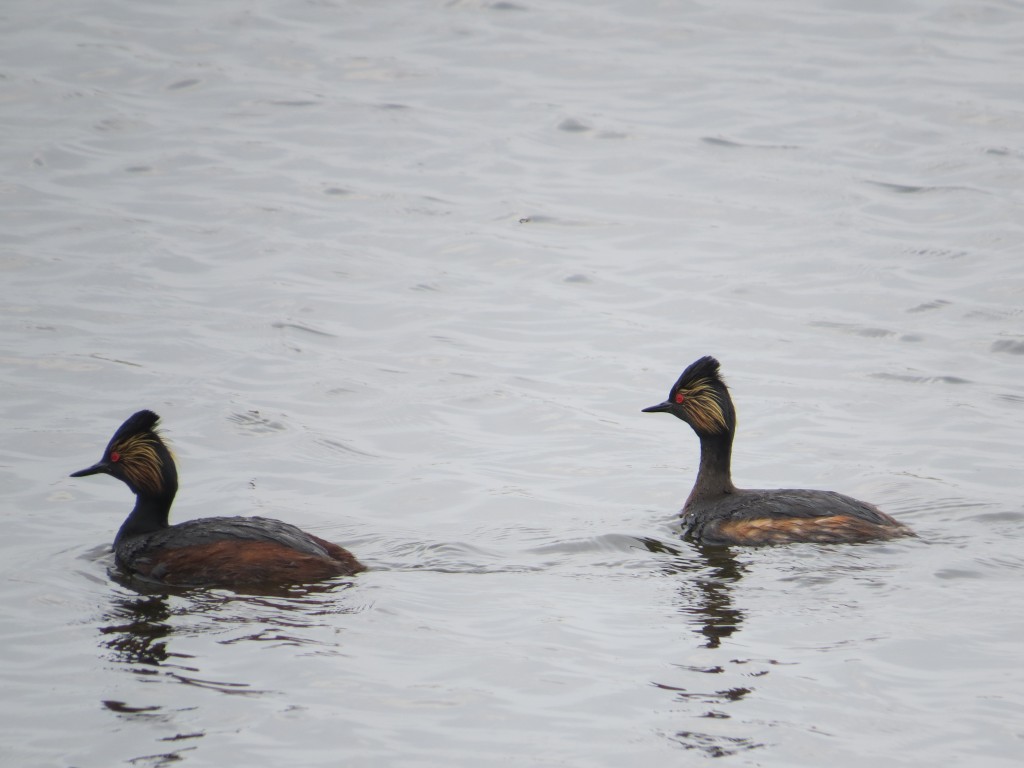
Eared Grebes
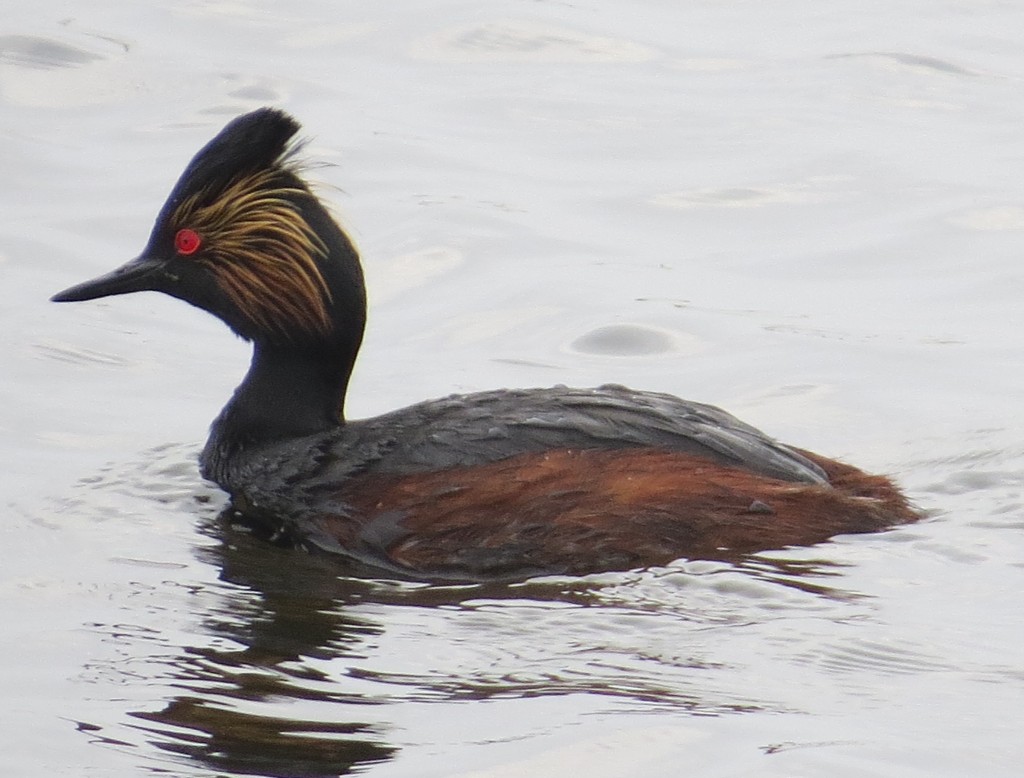
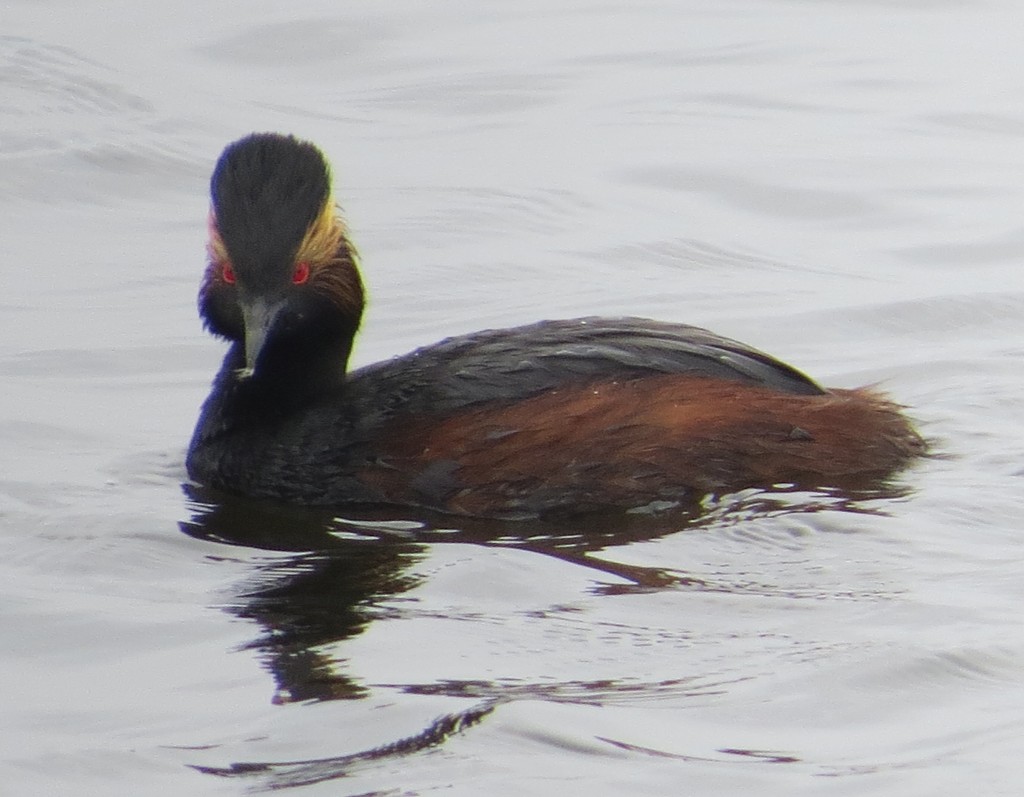 As much as we tried we could not turn up a Black-crowned Night Heron. I guess we can’t win it all, plus there was still more good birding ahead. Our next stop was the sewage ponds at the city of Herman where two Black-necked Stilts have decided to nest. Because of the work of some dedicated birders who brought this to the city’s attention, the city has agreed to not mow around this pond until the birds are done nesting. In fact, the townsfolk are pretty excited over the hub-bub at their local sewage ponds.
As much as we tried we could not turn up a Black-crowned Night Heron. I guess we can’t win it all, plus there was still more good birding ahead. Our next stop was the sewage ponds at the city of Herman where two Black-necked Stilts have decided to nest. Because of the work of some dedicated birders who brought this to the city’s attention, the city has agreed to not mow around this pond until the birds are done nesting. In fact, the townsfolk are pretty excited over the hub-bub at their local sewage ponds.
A nesting bird is easy to find. It is about the only guarantee there is when it comes to finding a bird. We were able to see both of the adults today. It was not a new bird as we saw them in Arizona a couple months ago, but it is a really fun bird that was a treat to see not far down the road from us.
You didn’t need any special optics to see these birds well, but an up-close view makes a good sighting even better.
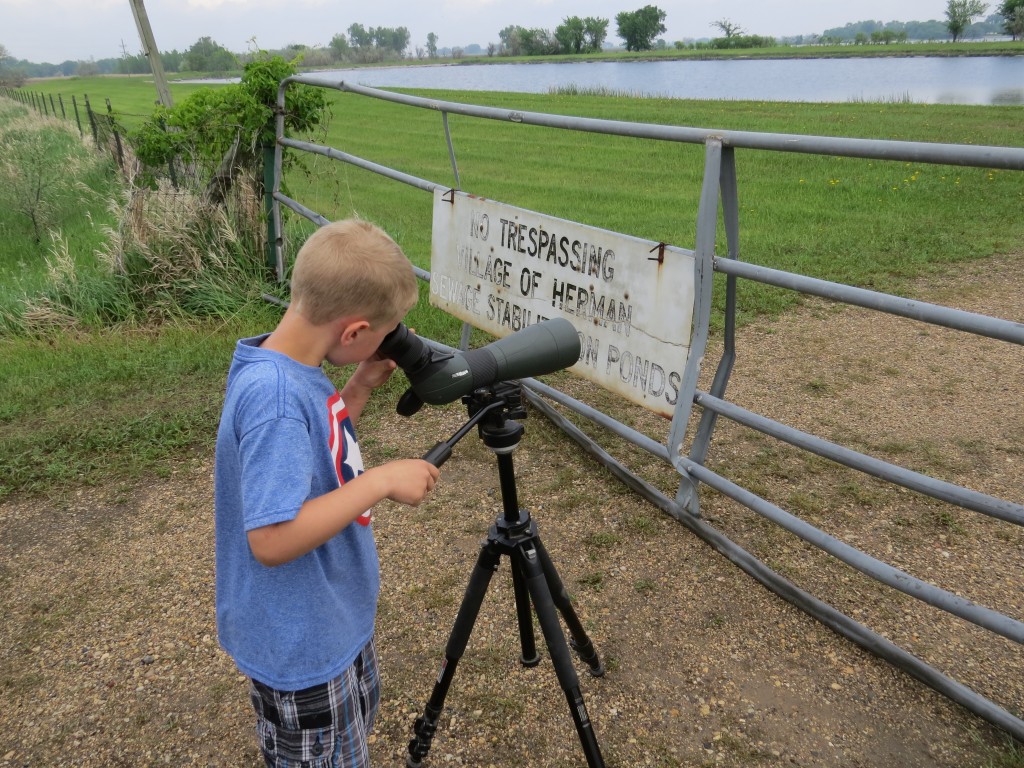 It was fun to see the female sit on the nest which has one confirmed egg.
It was fun to see the female sit on the nest which has one confirmed egg.
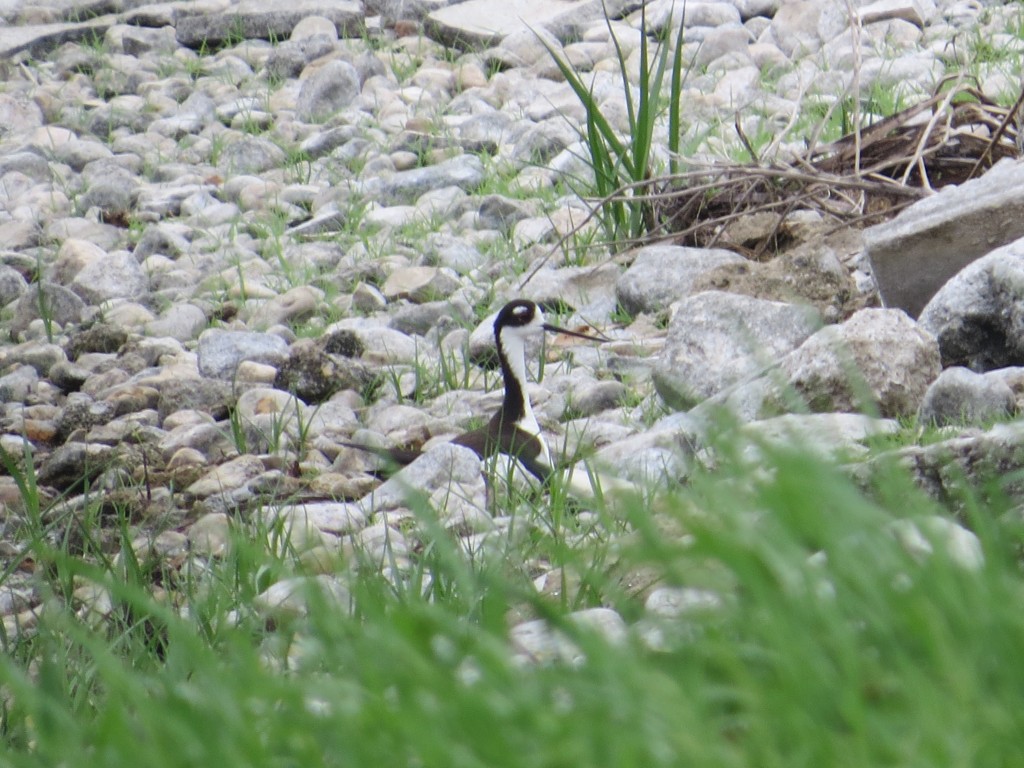
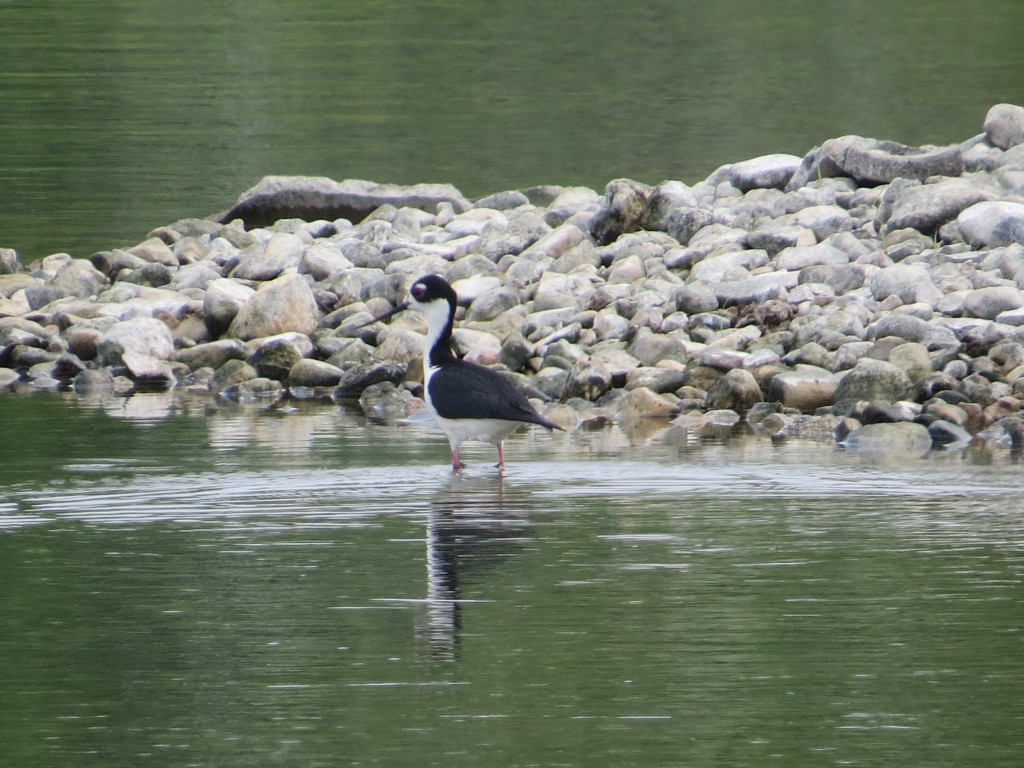
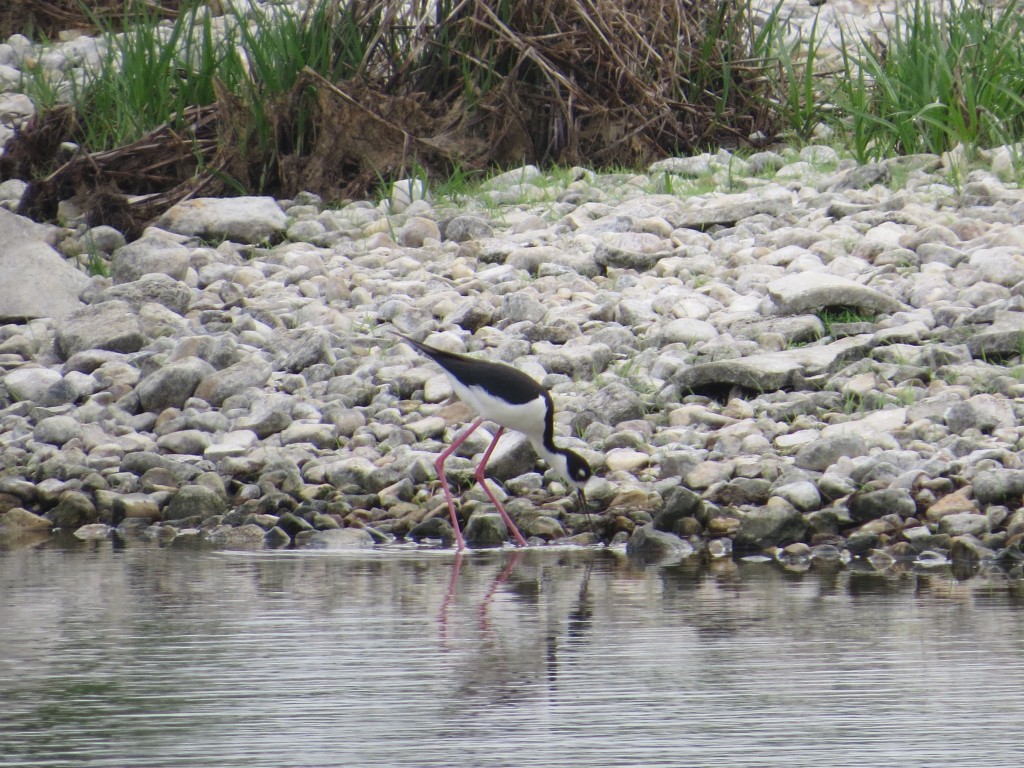
Black-necked Stilts – a most appropriate name
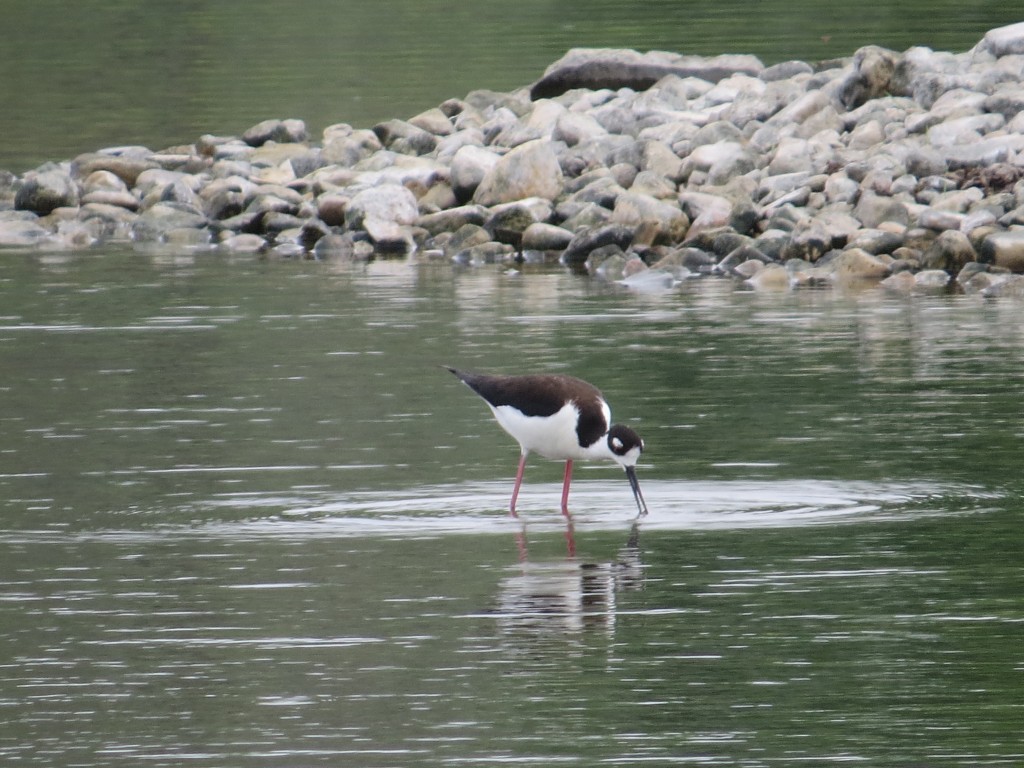
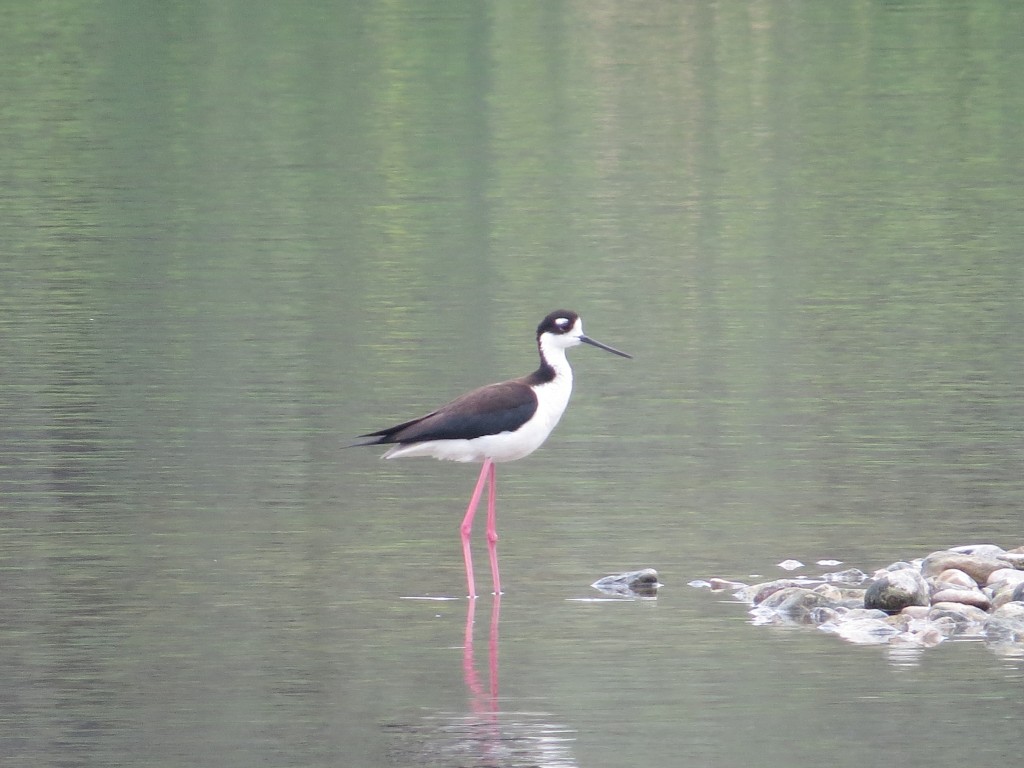
After the ponds we decided to see if we could find the reported Loggerhead Shrike just north of Herman. We couldn’t find it on our way to see the Black-necked Stilts. The second time was the charm, though, as Charlene’s parked vehicle on Hwy. 9 and pointed binoculars alerted us to its presence. In addition to her own rare yard bird, she was keeping tabs on all these other incredible finds within 10 miles of her home.
It’s always fun to see a shrike, but Loggerheads are rare in Minnesota, so they are extra special.
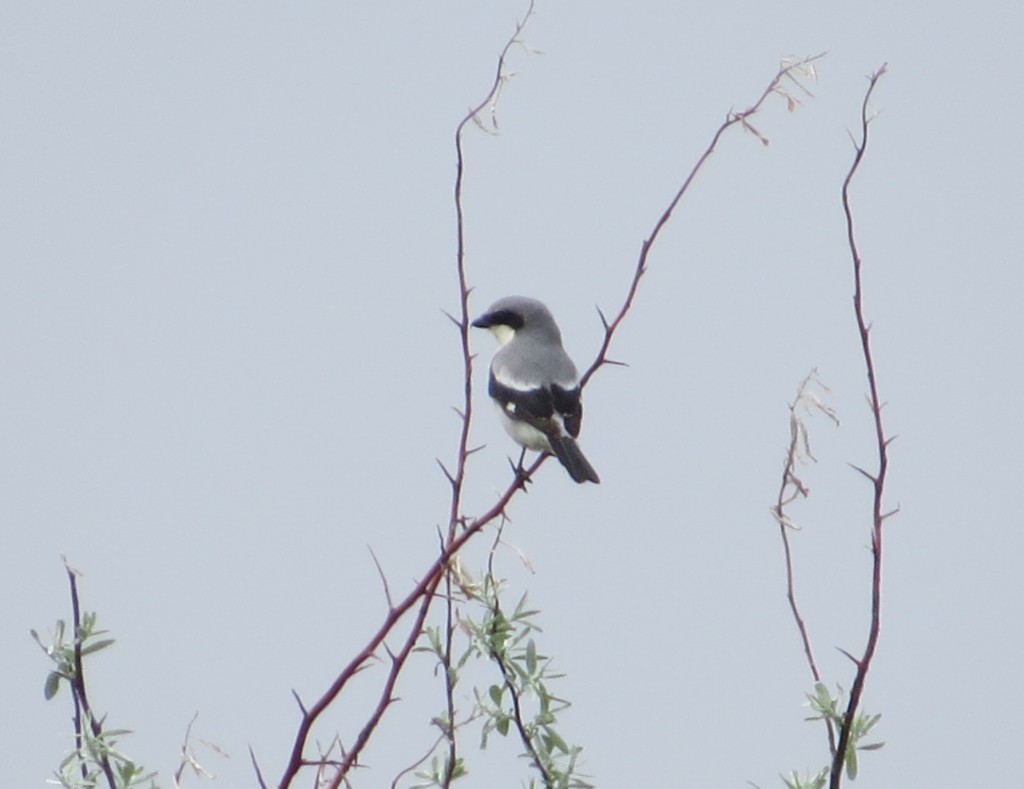
Loggerhead Shrike
And with that last sighting, it was time to head home. What a phenomenal day of birding it had been. Two life birds, a host of uncommon birds, and great company are tough to beat. It was one of those big birding days that will stand out for a long time in our memories. After all, how often will can a birder see a White-winged Dove and a Black-necked Stilt on the same day in Minnesota?
COPS: Pennock Sewage Ponds
The combination of the recent insurgence of shorebirds and the beginning of my summer vacation meant one thing – I had to go on a tour-de-ponds on Wednesday, hitting up the wastewater treatment ponds of three small towns in Kandiyohi County. (Tour-de-ponds/Turdy ponds – get it?) Evan still has school, so Marin and I dropped him off and embarked on our adventure. To keep it interesting for her, she was promised it’d be a tour-de-parks also where we’d stop at each town’s park to break up the trip.
Pennock was up first on the list. To get to the ponds, I had to drive south along a gravel trail for well over a half mile. I stopped to check out a Horned Lark. That was my second mistake. The first mistake was driving a mini-van, but I’ll get to that later. The berm surrounding the ponds was perpendicular to this road and directly in front of me. So I had to turn east to drive along the berm until I reached the corner and had to go south again. Why I am boring you with all this direction nonsense? Well, the berm surrounding these sewage ponds is tall. It’s so tall that you can’t see the ponds from your vehicle. You either have to get on top of your vehicle or cross the barb wire fence that is posted every hundred yards with ‘No Trespassing Signs’. Every single sewage pond I have been to has a fence around it with ominous warnings. To a birder it’s very frustrating. It’s kind of like this brand new slide Marin and I found that appeared functional and safe and yet was roped off until who knows when. “Here is something really fun kids and super safe, but back off!”

But I digress. I was driving around the ponds looking for any place where I might catch an easy glimpse of the water. Finally I stopped right by one of those pesky ‘No Trespassing’ signs. I thought to myself, ‘Come on, it’s Pennock, the middle of nowhere. No one’s gonna see me.’ I put the van in park and was about to open my door when I saw my rearview mirror was lit up with the blue and red flashing lights of a Kandiyohi County Sheriff’s squad car five feet off my rear bumper! Whoa, I had no idea how long he’d been in “hot-pursuit” of me since we were both a mile from the highway and I was driving all of 5 MPH the whole time.
A thousand thoughts raced through my head. Do I pull over? How do I pull over when I’m on a dirt path? Maybe I should just hop out and explain I’m just birding. Maybe I should grab my binoculars and show them so they can see that. No! Don’t hop out, are you stupid?! Binoculars? Are you nuts? Do you want to commit suicide by cop by jumping out with binoculars? It was terrifying, confusing, and even a little exhilarating. Finally a cooler head and many years of watching COPS prevailed – I stayed in my vehicle, rolled down the window, and shut off the engine. I decided to rest my arm on the door frame of the van. I know, he’ll see my wedding ring and know the mini-van is legit and this will all be one big misunderstanding.
After what felt like an eternity, the driver’s door of the squad car opened and the deputy began making his way to my window. His walk was slow as he hugged the inside edge of my car keeping one hand on his holster – no joke. I could tell he looked tense. It had to be the suspicious mini-van, my first mistake. No one goes to a sewage pond in a mini-van. Had I driven a truck or my SUV and wore a seed cap, those officers wouldn’t have thought twice about me being out here. Finally the officer made it to just behind my window as they are trained to do when approaching potentially criminal birders in suspicious mini-vans at sewage ponds.
“What are you doing here today?”
“I’m birding.”
Immediately the tension on his face broke as he burst into a smile and repeated, “Birding.” Any visions he had of a show-down at the Pennock Sewage Ponds must have vanished with my response. I, too, felt more relaxed, thinking that he would leave me alone now.
“We’ve had some reports of people messing with things here, so when we saw you parked we came to check it out (my second mistake of looking at the lark). We’ll have you on your way shortly, but I need to see your license and insurance card.” So apparently this constituted a traffic stop even though I was doing nothing wrong and technically wasn’t pulled over. Back to feeling like a criminal.
So I waited and waited. Finally I got my license back. “There you go, Josh. Have a nice day.” Hey, he used my name – I feel exonerated. So I watched him go in reverse down the dirt trail. I was waiting for him to leave so I could resume birding, but once he got to the corner of the ponds, he just stayed and watched me. I got out with binoculars and camera and went to a low spot in the berm where I could look over. Any thoughts of fence-hopping were completely gone. As I watched birds, he watched me and watched me and watched me. Back to feeling like a criminal. Finally I decided I’d had enough and got in the van. I, too, drove in reverse down the path which finally got him to move along. (How many traffic stops conclude with both officer and perpetrator going in reverse for a hundred yards?) When I got to the corner and could turn around to go forward, I was shocked to see a second patrol car with two more officers! Should I feel intimidated or honored that this birder required back-up?
Once I got back home I shared my anecdote with my birding buddies. One of them fessed up that he’d hopped that fence the night before. Aha! Another told me he’s been questioned by law enforcement three times in the name of birding, and then he proceeded to welcome me to the brotherhood. It actually was on my list of birding accomplishments/expectations. Put other birders onto a rare bird? Check. Find a county record? Check. Check. Check. Get stopped by police while birding? Check. I guess I’m now a bona fide birder.
It’s silly, really, how a mini-van, a lark, and a fence-hopping friend can all put you in bad light. I wasn’t speeding, making an illegal u-turn, nearly causing an accident, checking email while driving, or trespassing. And as to whether I’ve done any of those things in an effort to see a bird, I plead the fifth.
My birding mood was killed for a little bit, but after a recovery period at home I decided to get back on with the tour. It turns out that there would be more surpises in store for this day. That’s what I love about birding – you just never know what’s going to happen. And the cop stop is all part of the fabric of expecting the unexpected.
While I was letting Marin play at Atwater’s Centennial Park, I ran into a former student who’s now in college and was babysitting some kids at the park. After catching up a bit, she asked me if I was the one that was into owls. I told her that I enjoy them, yes. Then she said that there’s one in the park right on the ground down near the lake. What?!
So we all marched down there, with like a zillion kids in tow. She told me that it was in the middle of a huge Cottonwood tree and to see it you would have to walk to the shore, turn, and it would be five feet in front of you. So I followed her instructions and saw this guy! It was a Great Horned owlet.
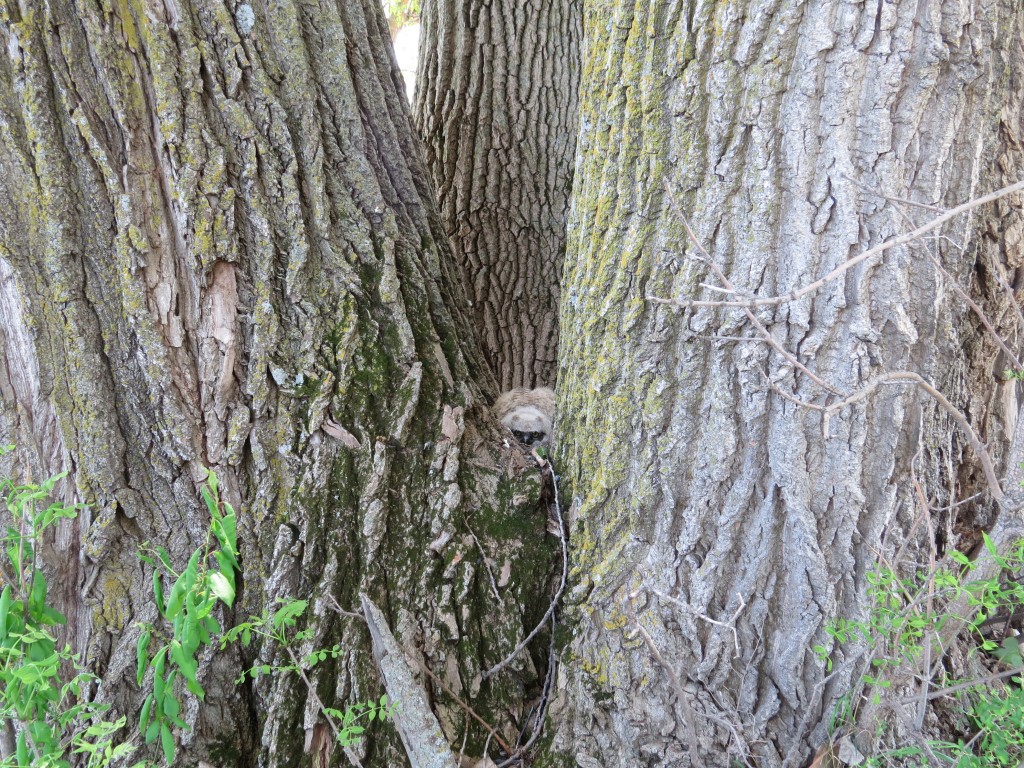
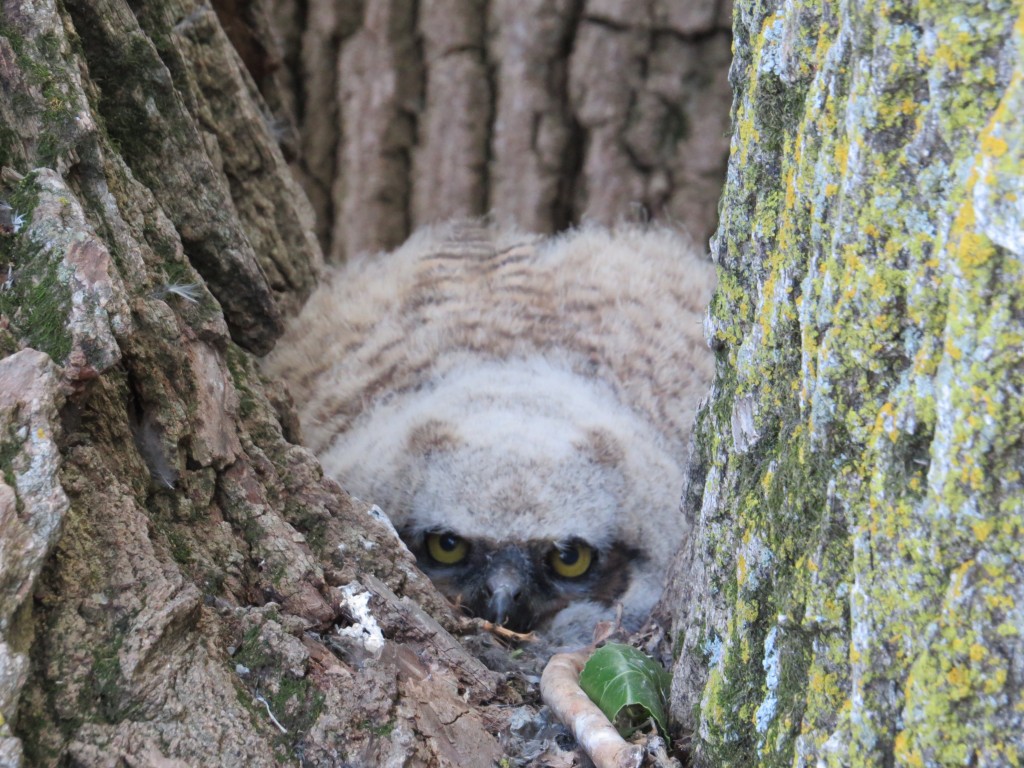
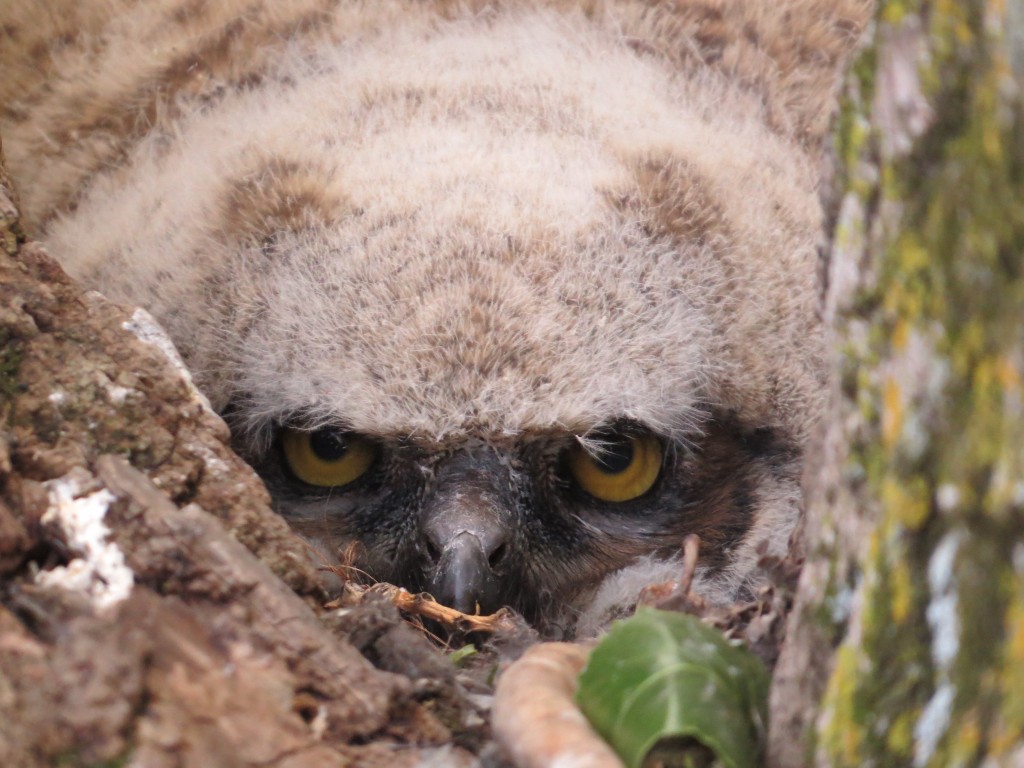
Poor thing. Every kid in town knew about this guy, especially with cell phone pics running rampant through social media. Making it worse is that you have to be within a few feet of the bird to see it. I heard one kid had been throwing sticks at it. Now where are those Kandiyohi County Sheriff’s deputies when you need them? I looked all over the massive tree above to find the owlet’s mom or dad, but I had no luck. I checked back on it the following day, and it was gone. I’m not sure how it left but was glad to see it out of such a public spot.
One of the last parks we went to was in the city of Lake Lillian. Now this was a good old fashioned park with splintery wooden teeter-totters (the kind where you could roll off when your end was on the ground, dropping your buddy on the other end like a rock) and huge metal slides that must reach at least 350°. Here’s my super cute, recent four-eyes trying to cool it down.

Not a safe park and no caution tape or razor-wire fence keeping us out. It just didn’t fit the profile of the day.
 As Marin enjoyed the dangerous park, my ear caught the summer sound of an Eastern Wood Pewee. It didn’t take long to find it.
As Marin enjoyed the dangerous park, my ear caught the summer sound of an Eastern Wood Pewee. It didn’t take long to find it.
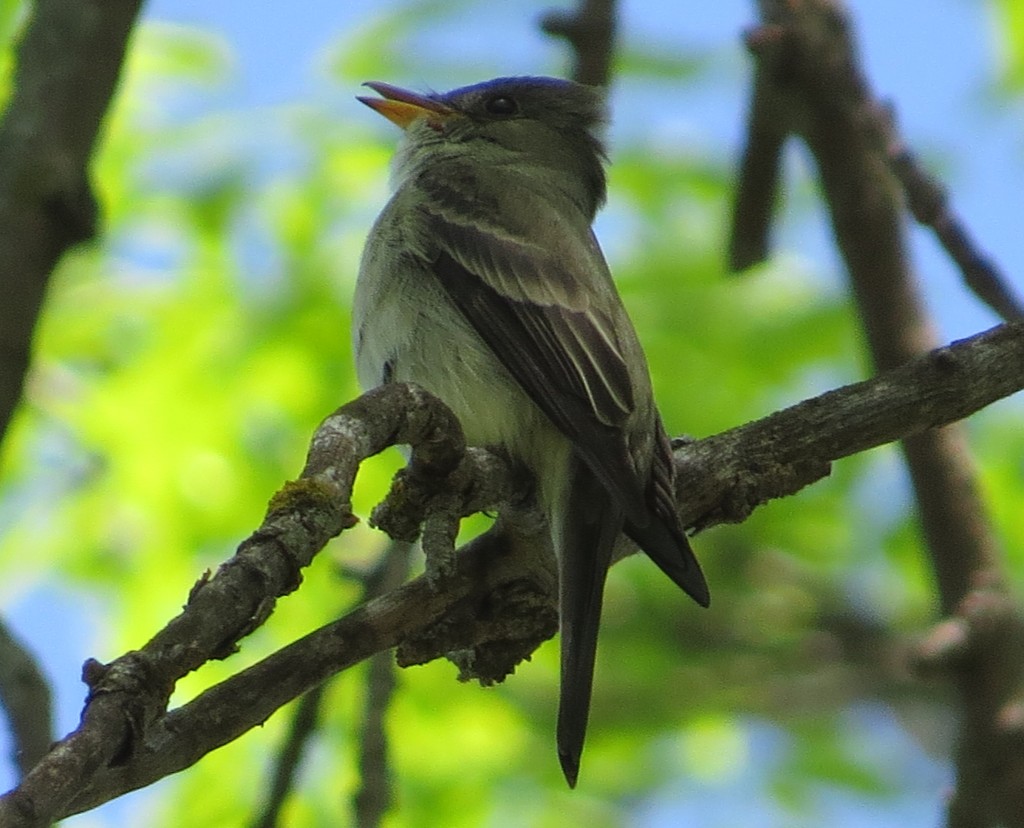
Eastern Wood Pewee
Later on I nearly had my second heart attack of the day when I was sitting on a park bench watching Marin. A dove landed two feet away from me on the ground. It took me a bit to take in what I was seeing – tiny dove, scaled back. Then it hit me – it was the Inca Dove, a southwestern specialty we had seen in Arizona! Stupidly my camera was in the van at this point. I froze and couldn’t even get my phone out for a picture. Finally the dove flew. Noting where it landed, I dashed to get my camera and come back. If it were an Inca Dove, no one would believe me without proof. It took me a half hour to relocate it, but I finally found it in a tree. It turns out it was a juvenile Mourning Dove, which seems oddly early. Rats.
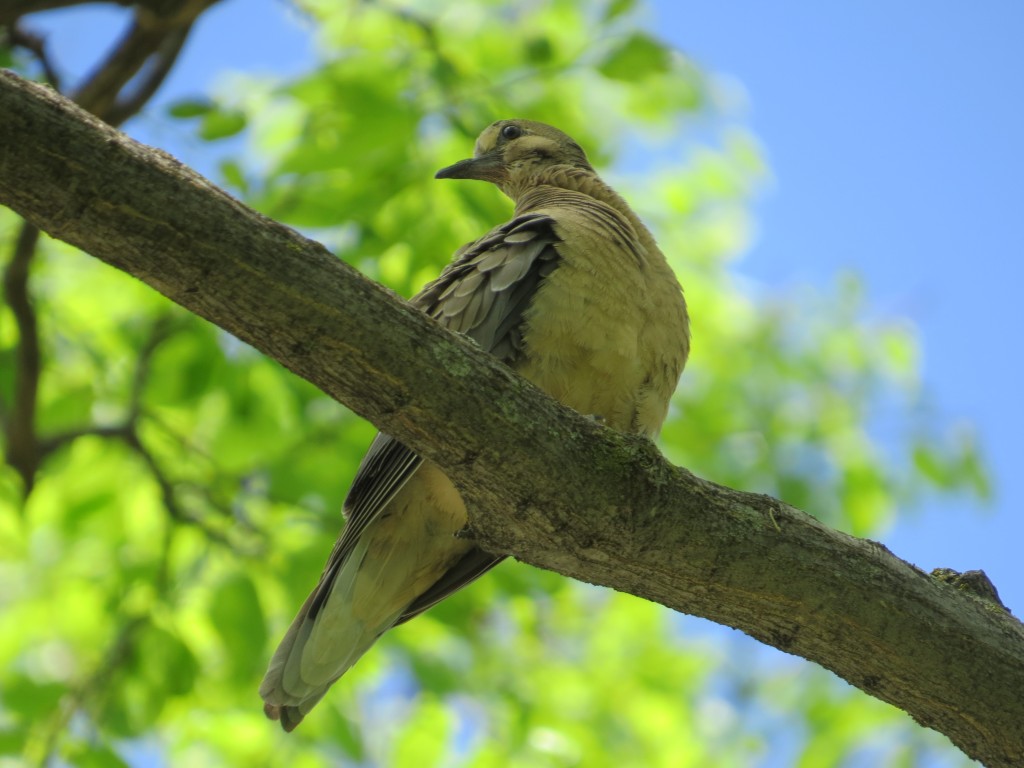 It was interesting to read in the field guide that these juveniles are commonly mistaken for Inca Doves. It was fun, nonetheless, to have this little learning experience, but I could have done without that second adrenaline rush of the day. Whoever said birdwatching was a lame activity for old people?
It was interesting to read in the field guide that these juveniles are commonly mistaken for Inca Doves. It was fun, nonetheless, to have this little learning experience, but I could have done without that second adrenaline rush of the day. Whoever said birdwatching was a lame activity for old people?

